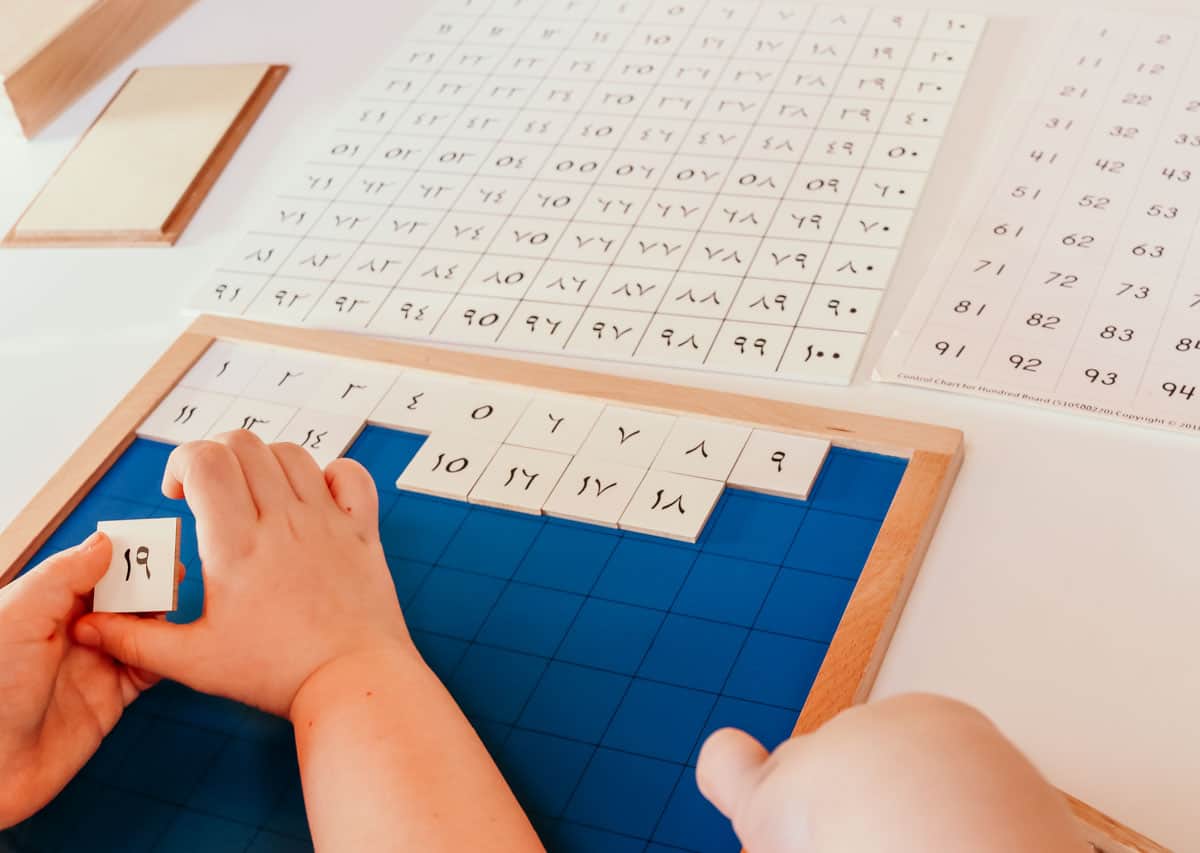
"So appears the greatness of man...explorer of the whole world and universe outside it, able even to go back in time, and explore what has long ceased to be. Every subject of our interest and study can be related to human beings, who have toiled, often starved, to overcome obstacles for its understanding, and to give us knowledge free of such pains. Everything is the fruit of a human soul, and we incarnate this fruitage in education, this treasury of riches handed on to us by man...the children can easily be brought to thrill to the knowledge that there are millions of people like themselves, striving mentally and physically to solve the problems of life, and that all contribute to a solution..."
- Maria Montessori
We're excited to share the Fifth and final Great Lesson with you all today. We have really enjoyed our exploration of the Great Lessons. The Five Great Lessons ignite the curiosity and enthusiasm that the children carry with them throughout the rest of their year as they continue to explore various topics.
We spend time exploring works related to The Story of Numbers and our follow-up work contains a nice mix of printables, hands-on activities, and time spent in nature.
Also, we learned about Día de los Muertos, a joyful 2-day cultural holiday commemorating life and death, that takes place Nov 1 & 2, and how to make Pan de Muerto.
Jump to:
Disclosure of Material Connection: Some of the links in the post are “affiliate links.” This means if you click on the link and purchase the item, I will receive an affiliate commission. Amazon links are not affiliate links. You can read my full affiliate disclosure.
The Fifth Great Lesson in Montessori’s Cosmic Education a.k.a. The Story of Numbers introduces students to various forms and methods of counting and record-keeping. Ancient methods saw the use of concrete materials and were important for agriculture and farming records as well as trading. They were eventually abstracted out to a writing system similar to what we saw during the Fourth Great Lesson.
Eventually, more advanced number systems were used to count, measure, and weigh. Days were divided to create a time-keeping system. Stars and planets were tracked to create a calendar system. The lesson concludes with various number systems, some of which are still in use today.
This lesson is traditionally given to Elementary students after The Fourth Great Lesson Follow-Up work is complete. It tells the story of how our uses of mathematics and record-keeping have grown and changed over time.
Our Montessori Fifth Great Lesson Materials and Follow-Up for Primary and Elementary covers Sensorial, Practical Life, Language, Math, Science, Nature, Geography, History, Culture, and Art. There are many different directions you can take with this lesson. This is how we did it.
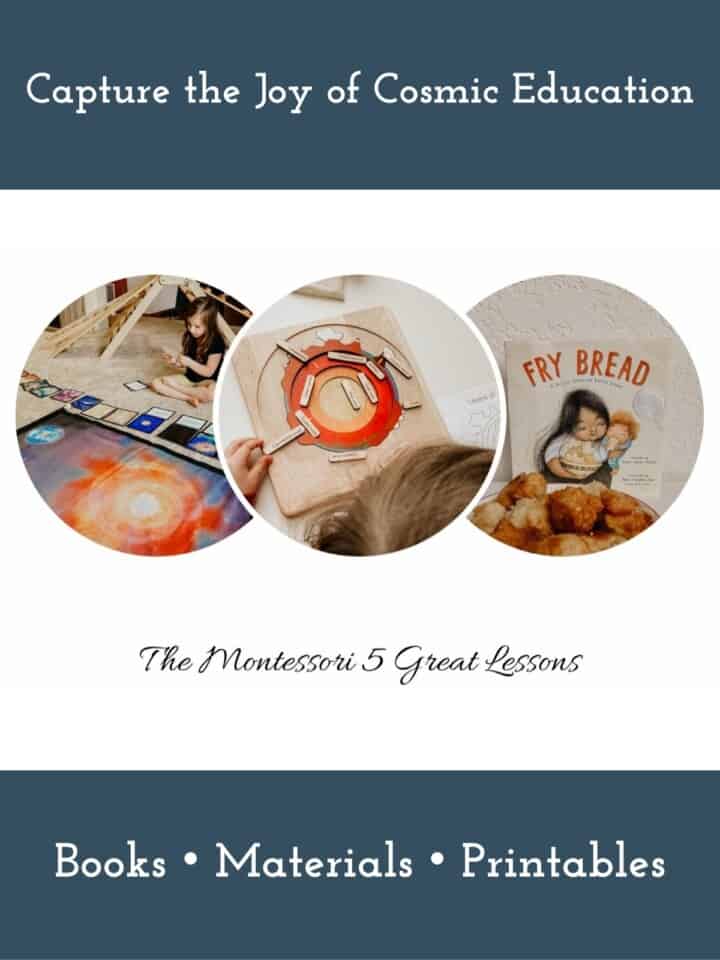
How to Homeschool Elementary
A Family-Style Approach to the Montessori Great Lessons
Free Montessori Great Lessons Series
Do you want assistance with planning your year? We've put together a FREE series on the Great Lessons for elementary and family-style learning that will take the overwhelm out of the beginning of your school year and keep you moving with ease all the way to spring.
Explore the Montessori Great Lessons, the introduction to the Cosmic Curriculum, traditionally given to Elementary students near the beginning of the school year. This free 5-part weekly email series will help you tell the story of how our universe began all the way to the origins of language and numbers.
Montessori's Five Great Lessons provide children with a contextual understanding of who they are, where they come from, and their unique purpose or cosmic task. Sounds like a big undertaking, right? Well, it doesn't have to be.
Learn more about this elementary homeschool course.
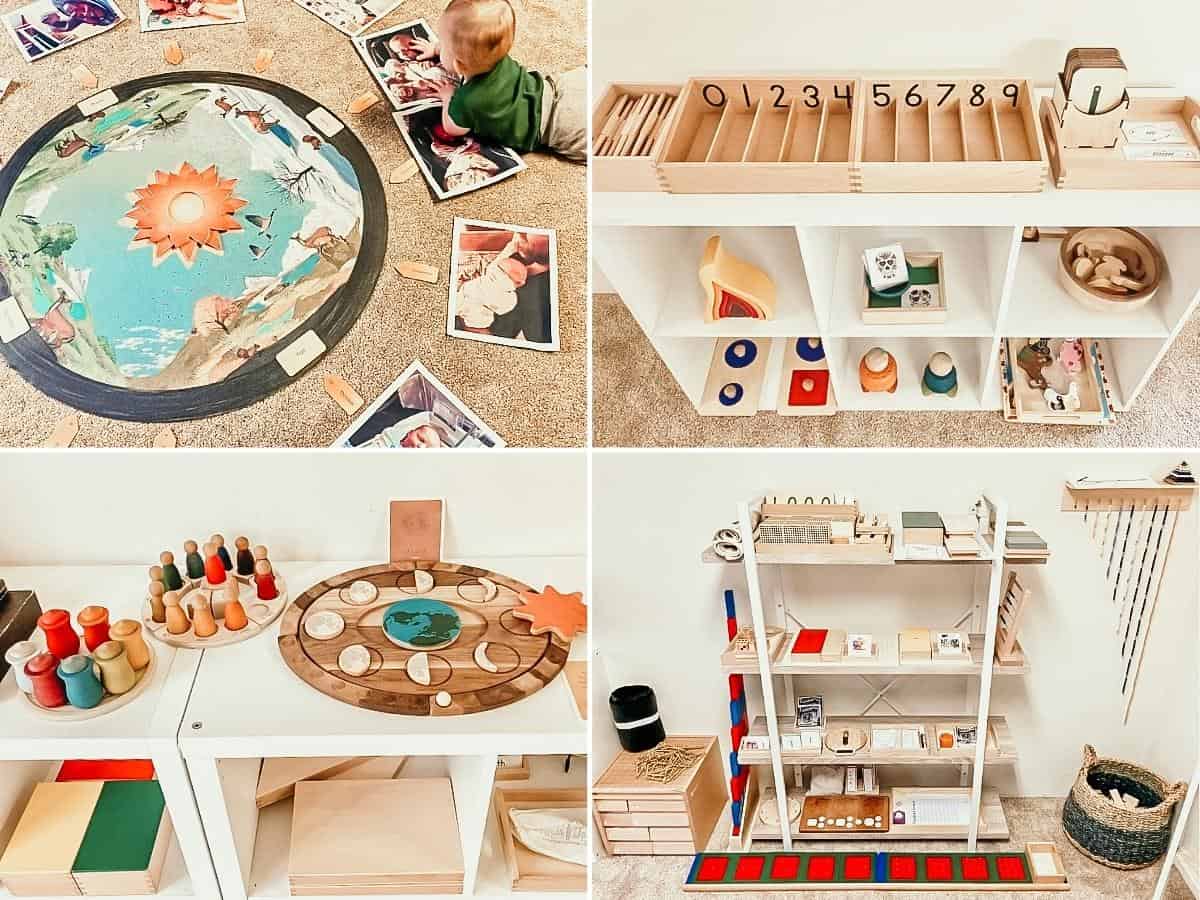
History of Numbers for Kids: The Montessori Fifth Great Lesson
This Montessori Fifth Great Lesson contains materials and follow-up work for all ages, but especially ages 2-12. It contains books, printables, and hands-on activities. More specifically, it covers topics such as Ancient Counting Systems, Time and Calendar Systems, Measurement, Number Systems, and Geometry.
We also revisited some of our Measurement activities from our Second Great Lesson and our History Timeline Cards from our Third Great Lesson.
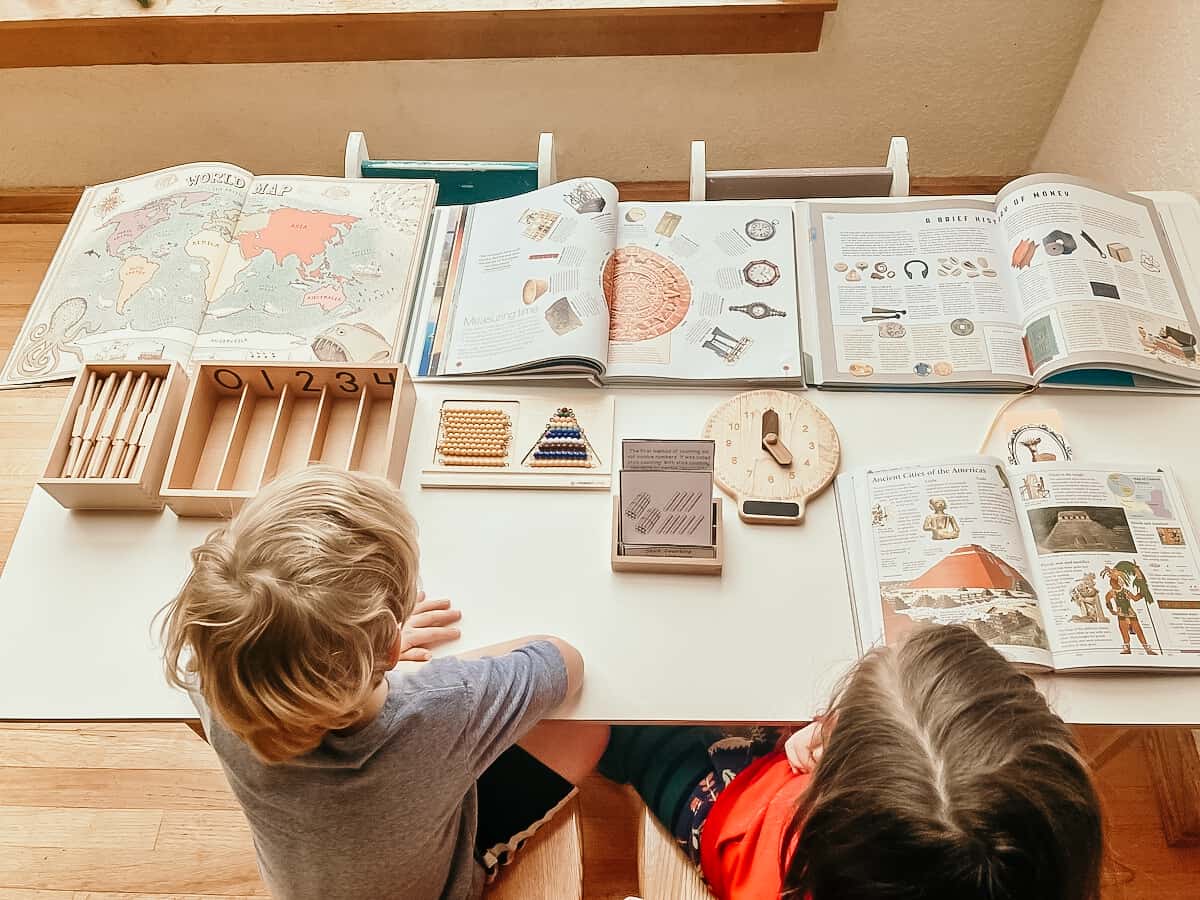
Fifth Great Lesson
To deliver the lesson, I used the Fifth Great Lesson Story and Nomenclature Cards from this Montessori Great Lessons - Stories & Activities Printable. Noah decided he wanted to sit in on this lesson and I don't doubt he was interested. We had a lot of materials out for the History of Numbers to stimulate interest and for comparison as we made our way through the Nomenclature cards.
Stick counting sounded a lot like spindle boxes and tally marks. Clay counting pebbles sounded similar to colored beads or golden beads.
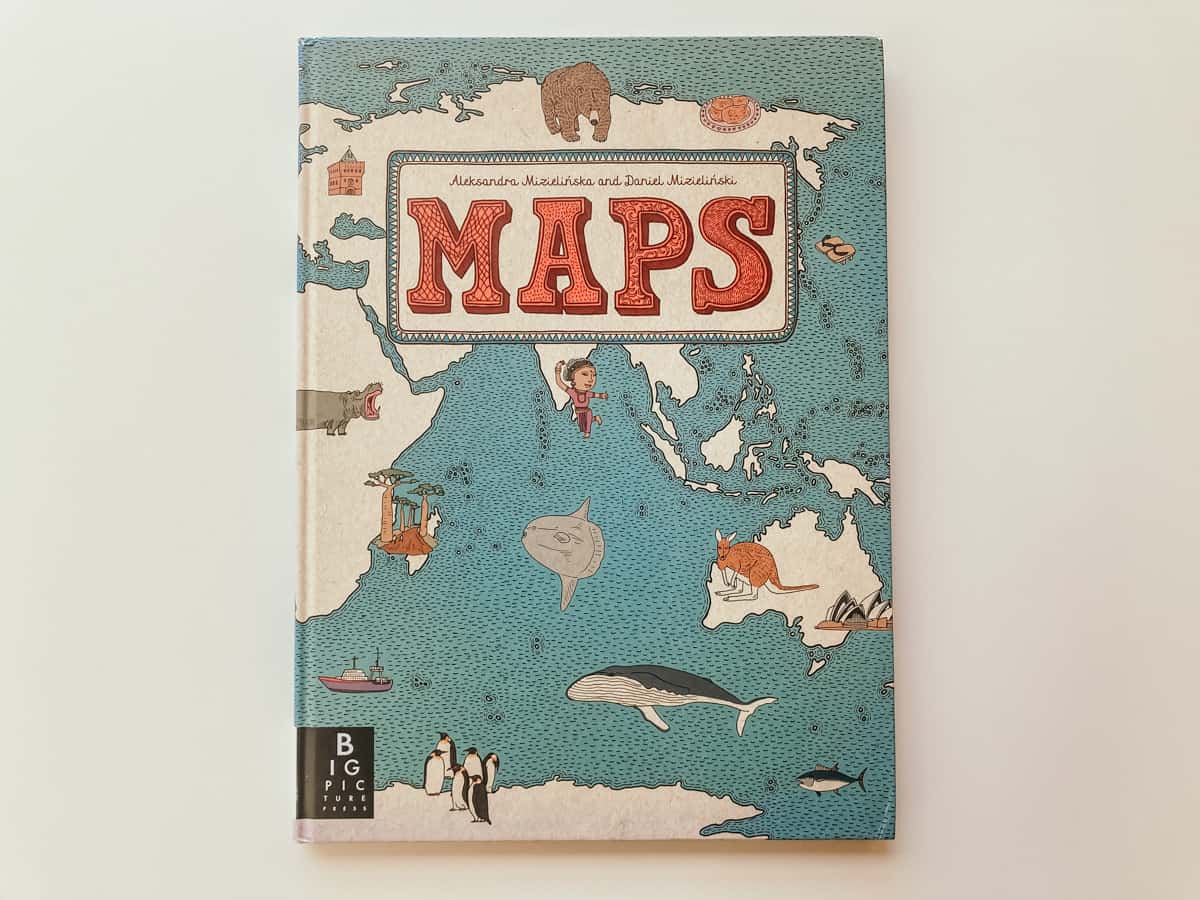
Books
Maps is helpful for providing a visual representation of the location of various civilizations we discussed. Again, you need some good maps to bring the story to life.
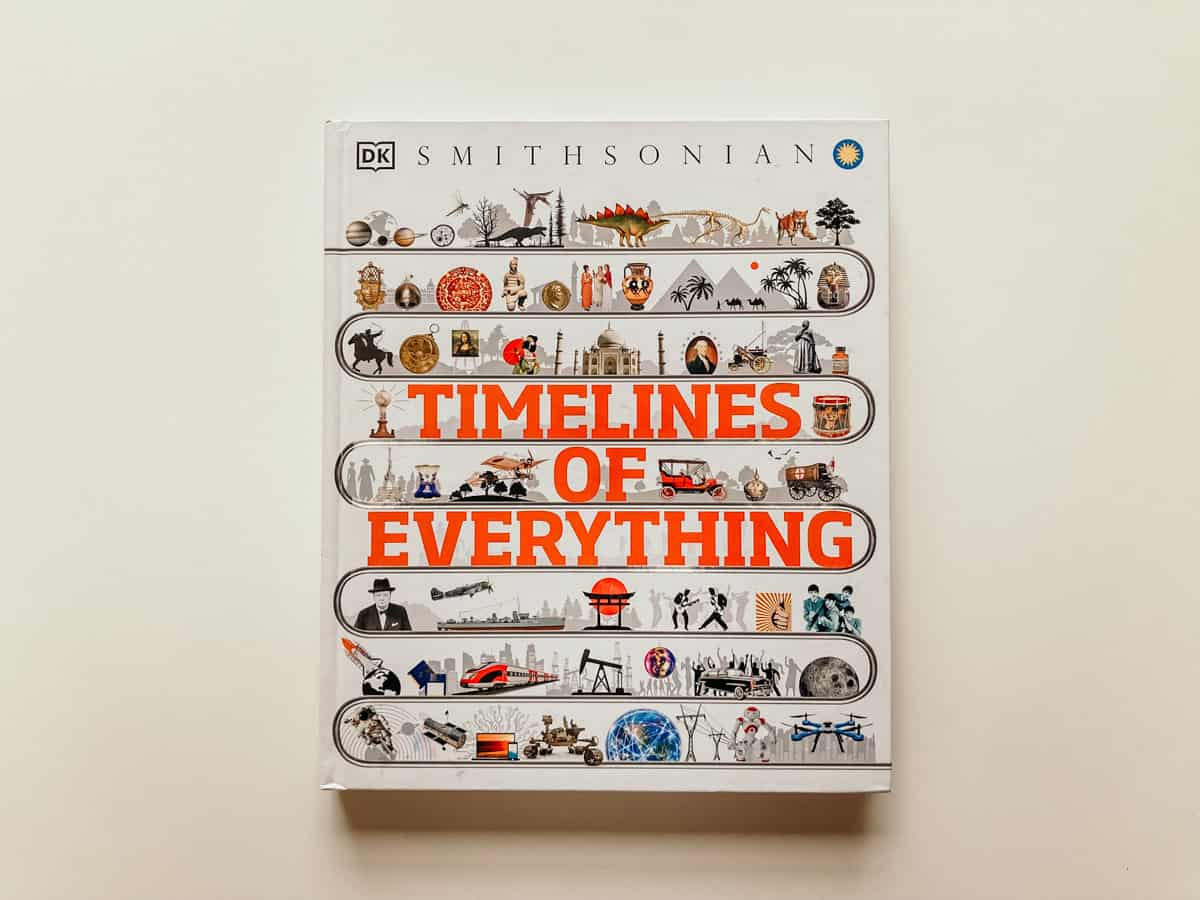
Timelines of Everything has a cool section on time and mechanical clocks.
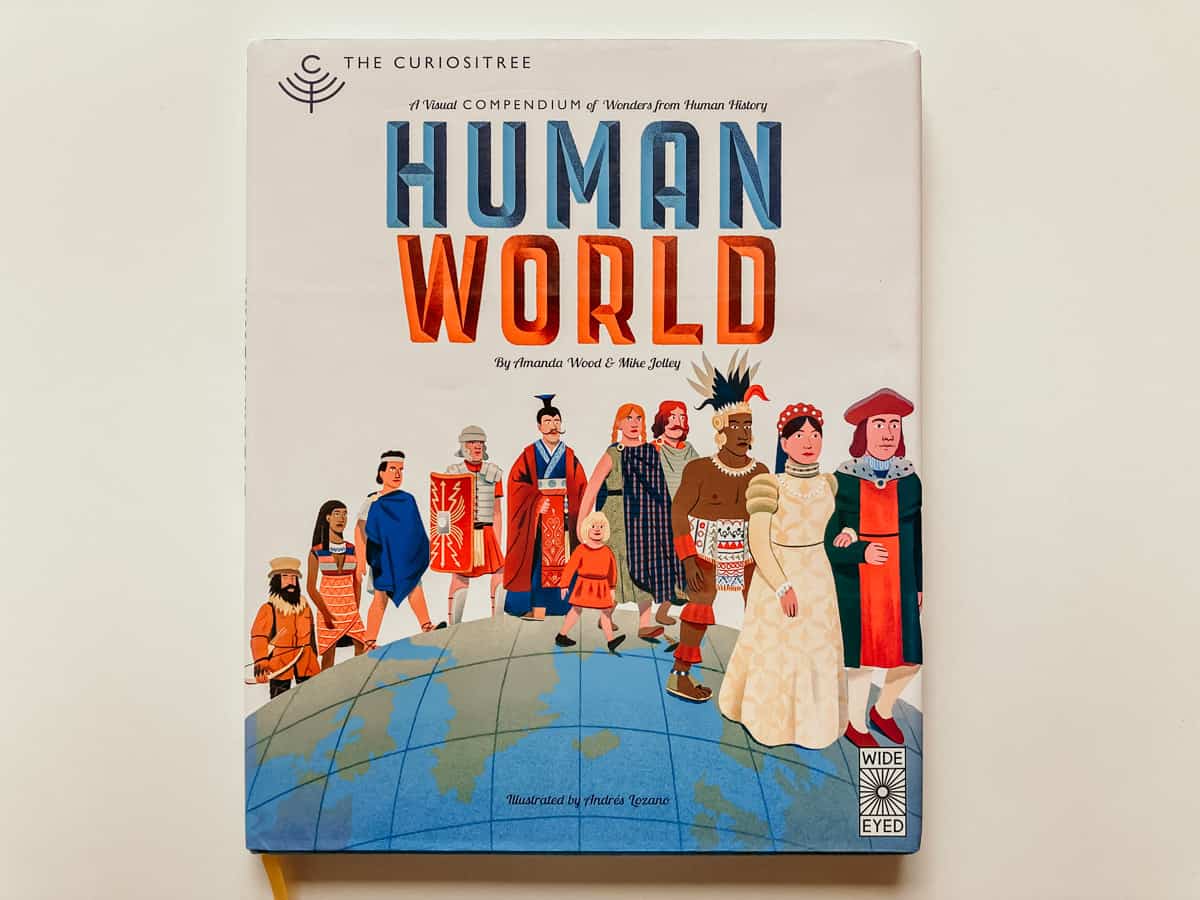
Curiositree Human World: A Visual History of Humankind has an awesome section, "A Brief History of Money", that everyone thought was cool. It had a lot of information packed into that one section and it ignited a lot of interest in their money activities later on.
Lastly, this Encyclopedia of World History provides more visual examples of number systems in various civilizations. For example, the Mayans had a number system consisting of only 3 number symbols: a shell, a dot, and a bar.
Most of these books are also used in our Montessori Fourth Great Lesson. Since the progression of the Story of Numbers is very similar to the progression our little ones practice their math skills, I thought we'd start with our youngest counter.

Counting, Comparison, and Sorting of Items Found in Nature
The kids are always collecting things during outdoor play. Flowers, bugs, rocks, sticks, acorns, bones, feathers. I could go on. This is also our favorite way to explore sorting, counting, number quantity, and on-to-one correspondence.
If you're looking for some sorting ideas and inspiration, Julie from Nature Inspired Learning will show you the 50 Best Sorting and Classification Activities for Preschoolers.

I've never seen m&m's 'disappear' quicker than they did while sorting them for this funfetti dip flag. Lots of fun!
Learn more about homeschooling in the preschool and kindergarten years with this free homeschool course.
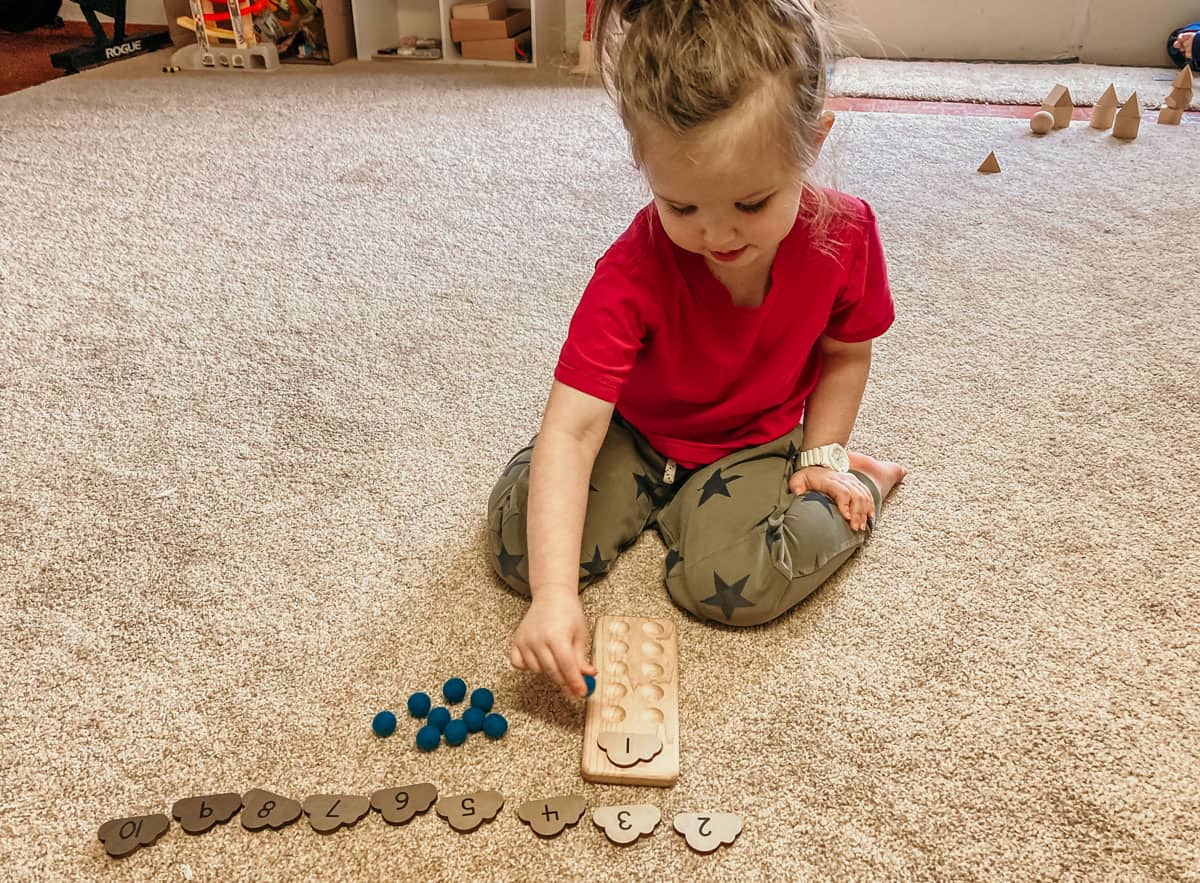
The Mirus Toys ten frame reinforces counting and number sense. You can use it for addition and subtraction lessons. It's also the perfect material for demonstrating the water cycle with preschoolers. As the numbers increase, the clouds get darker. Do a demo and see for yourself.
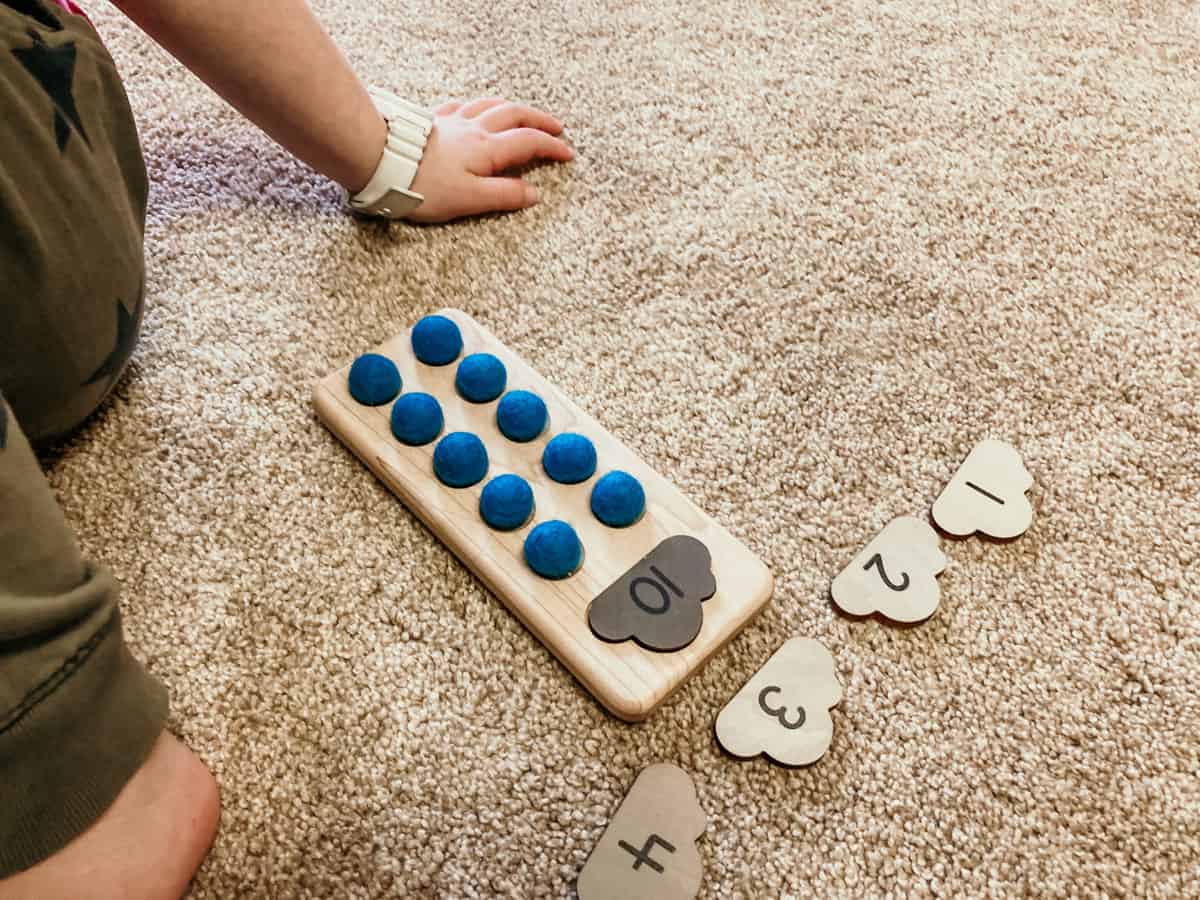
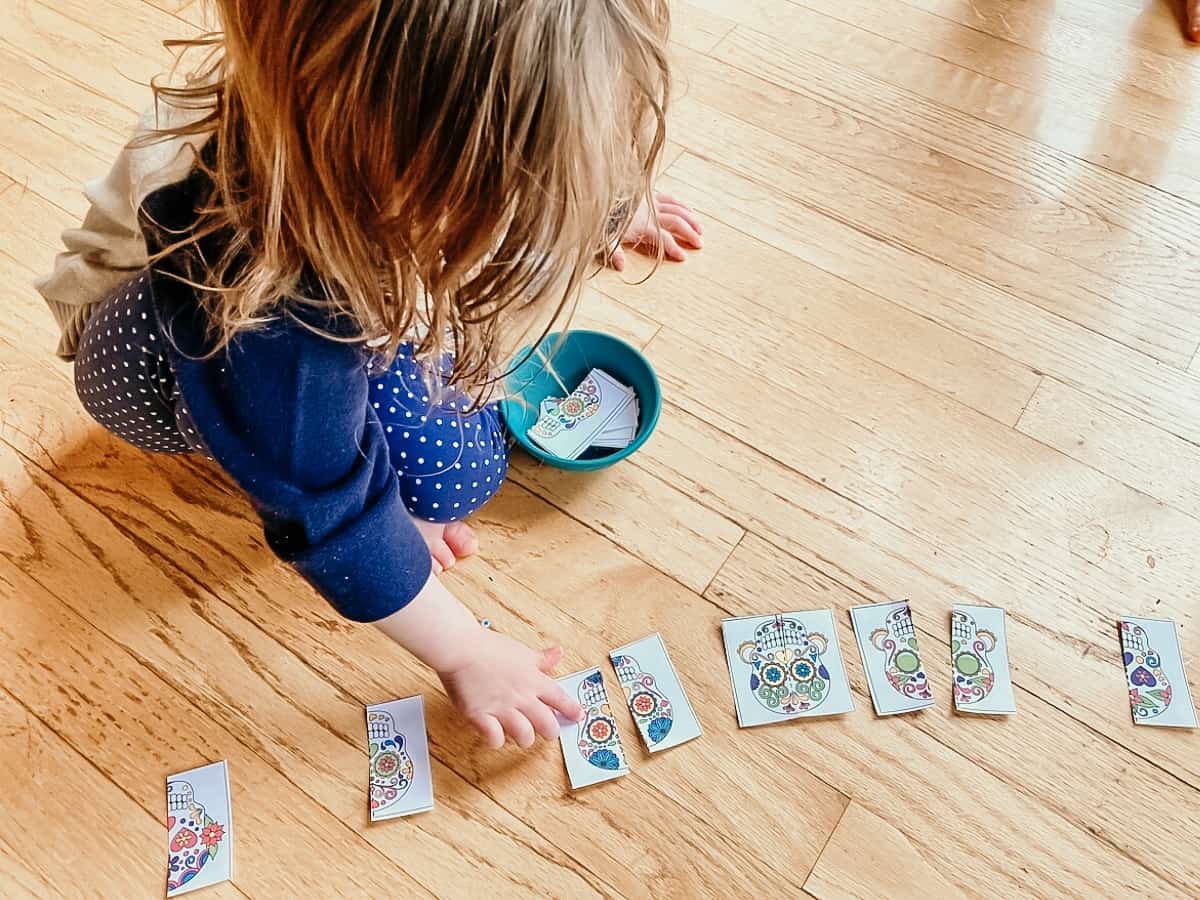
Comparison Shelf Work
These FREE Day of the Dead Skull Puzzles are a big hit right now. The kids enjoy matching the halves of the skull based on their intricate and colorful patterns.
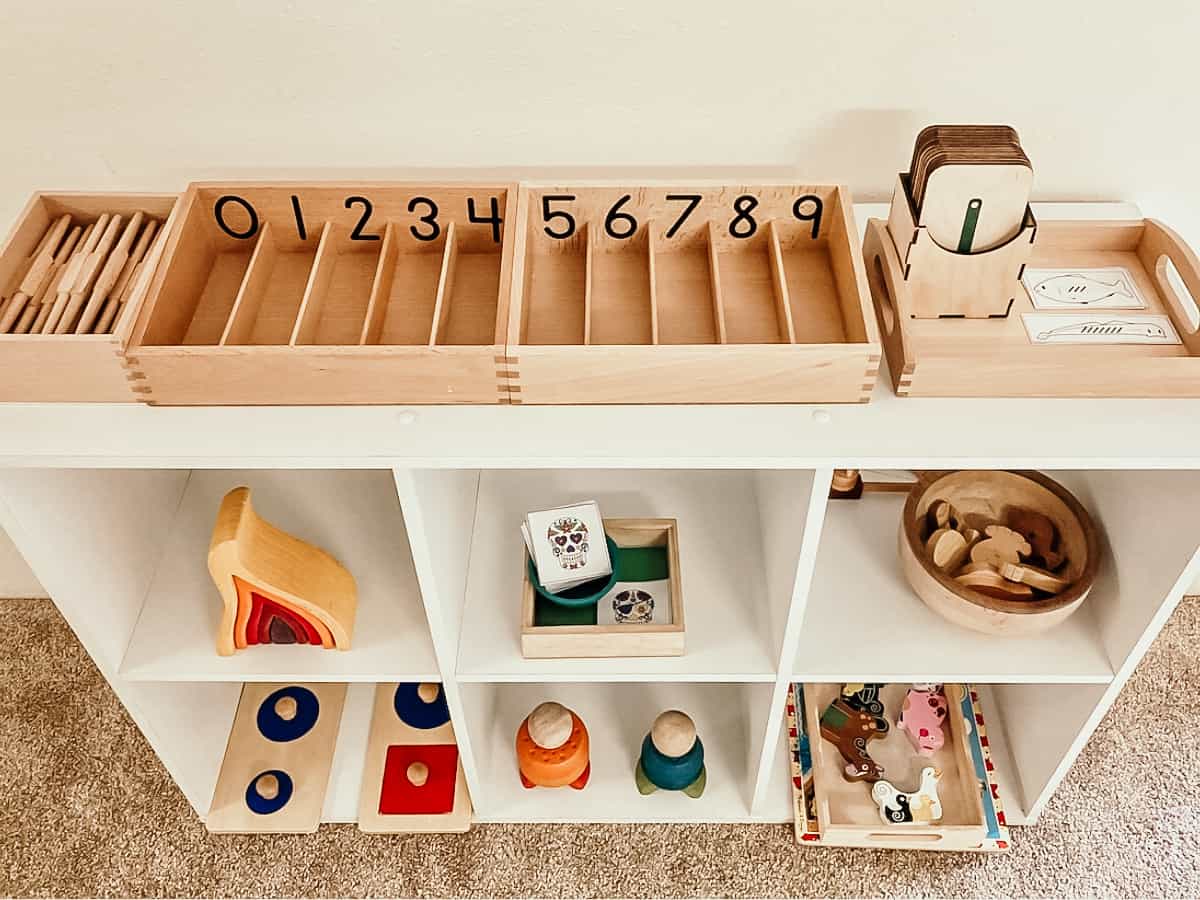
Toddler & Preschool Math Shelf Activities
- Spindle Box
- Montessori Numeral Cards and FREE How Many Bones?
- Fire Stacker Puzzle
- FREE Day of the Dead Skull Matching
- Fishing Game
- Shape Puzzles for our youngest
- Nuts & Bolts
- Farm Puzzle
These are the beginning Math activities accessible to Katalina. The How Many Bones? activity is adapted from a free printable provided by the Confederated Tribes of Grande Ronde and it uses stick counting to identify how many fish and eel bones are on each salmon and eel card.
The spindles from the spindle box activity can be used as manipulatives for this work. The numeral answer is written on the back of each card for control of error. It's pretty cool that we can use this as part of our History of Numbers after we explore the Chinook Salmon in our Fourth Great Lesson.
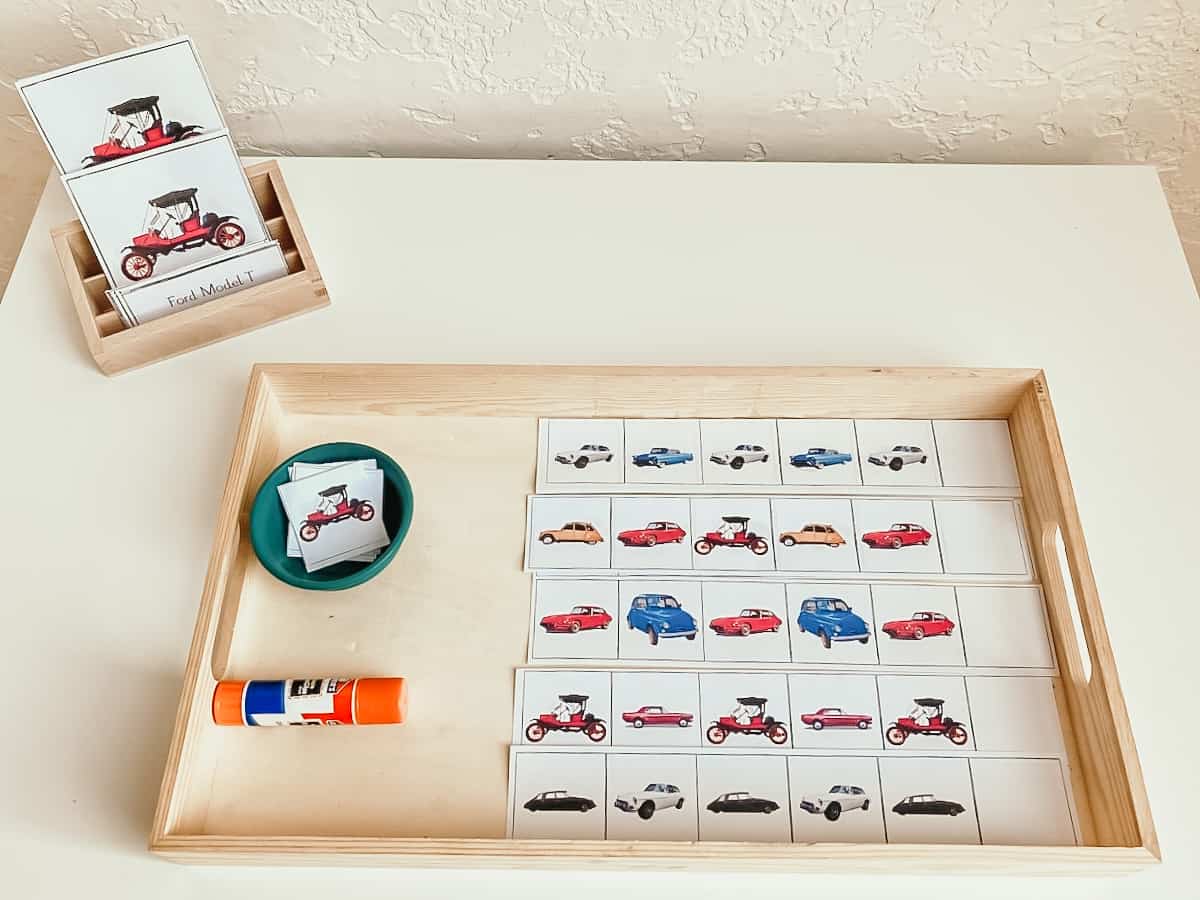
Classic Car Pattern Matching
If you're one of our subscribers, you know how much Noah is enjoying Montessori Living Room's Classic Cars shelf work. This particular tray has classic car pattern matching and it was one of my son's favorites.
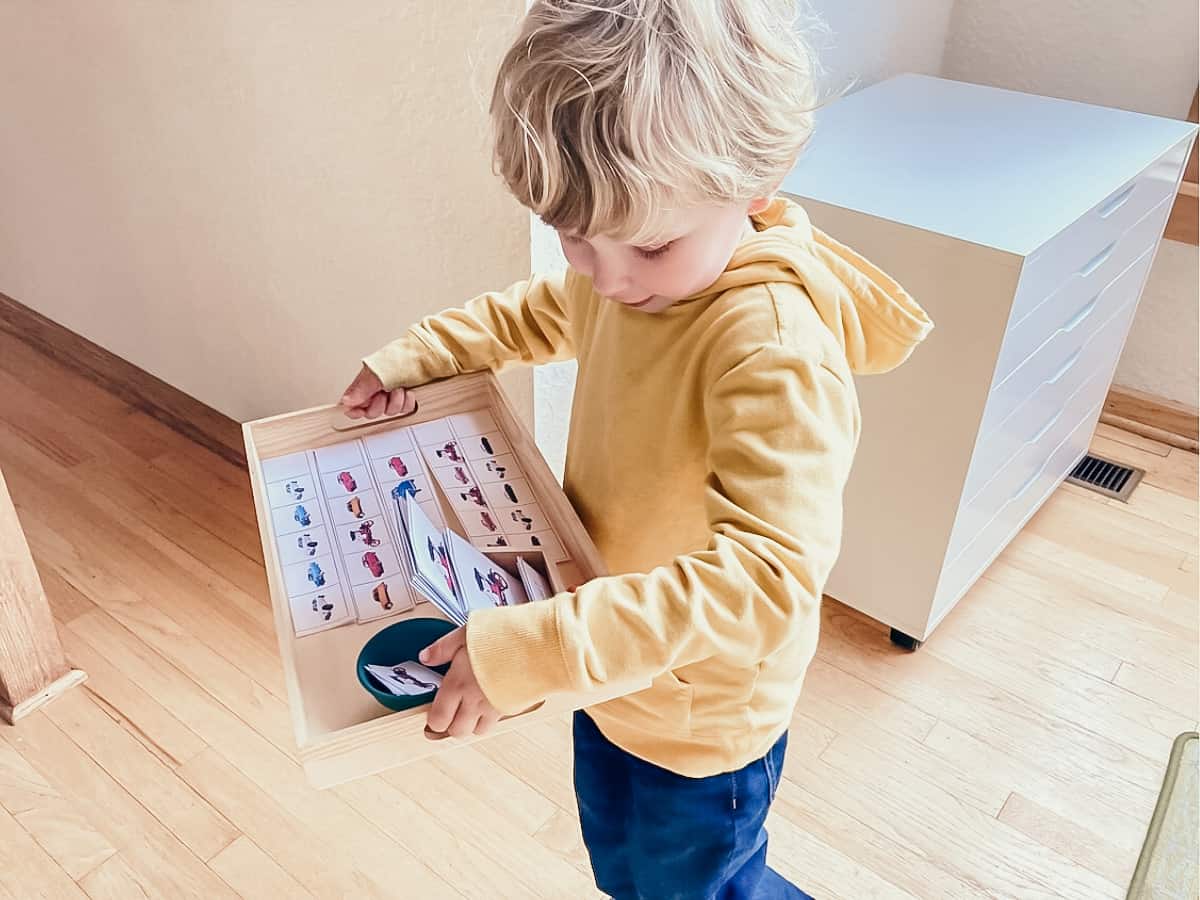
There he goes, never to be seen again. Kidding. However, he was engaged in the pattern-matching activity for a while. Afterward, he sat admiring the nomenclature cards for each classic car.
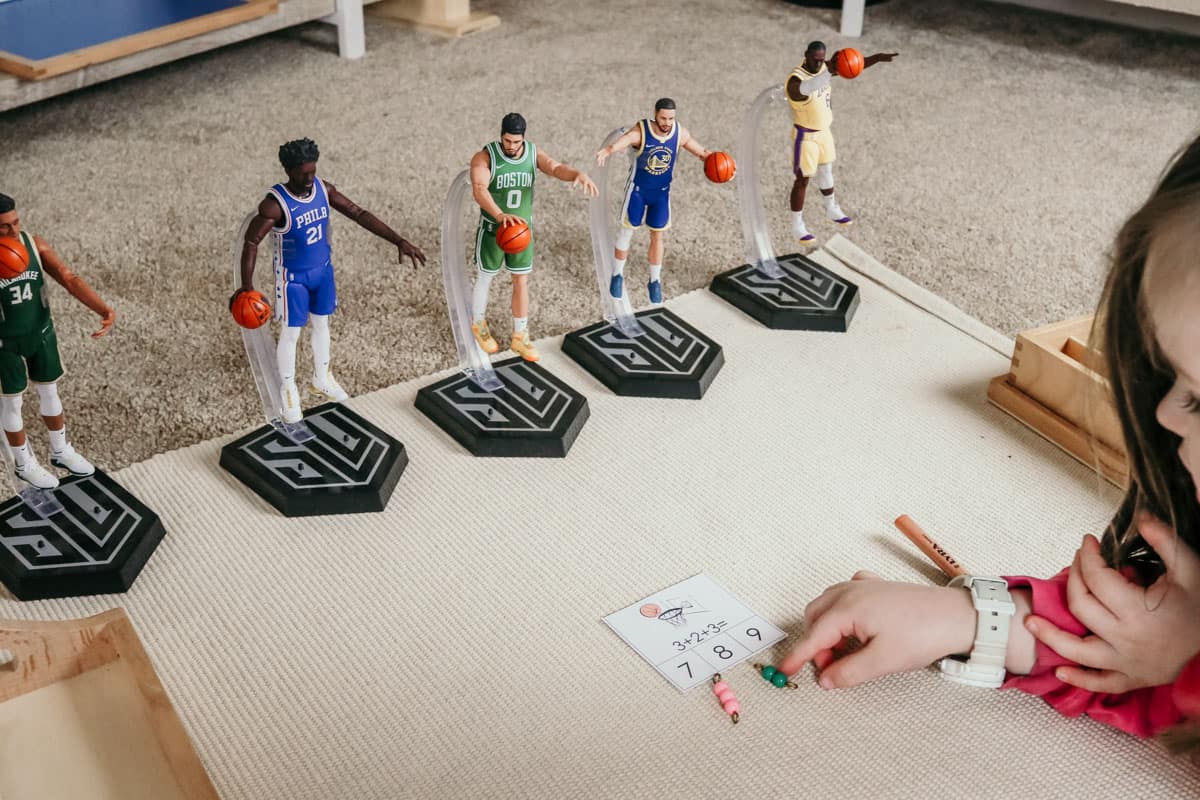
The March Madness Math Printable Pack with the Decanomial Beads allows kids to practice their addition skills.

As part of our 5th Great Lesson studies, the history of numbers, Kaia & Noah worked with the hundred board using the Arabic hundred board tiles from Alison's Montessori.
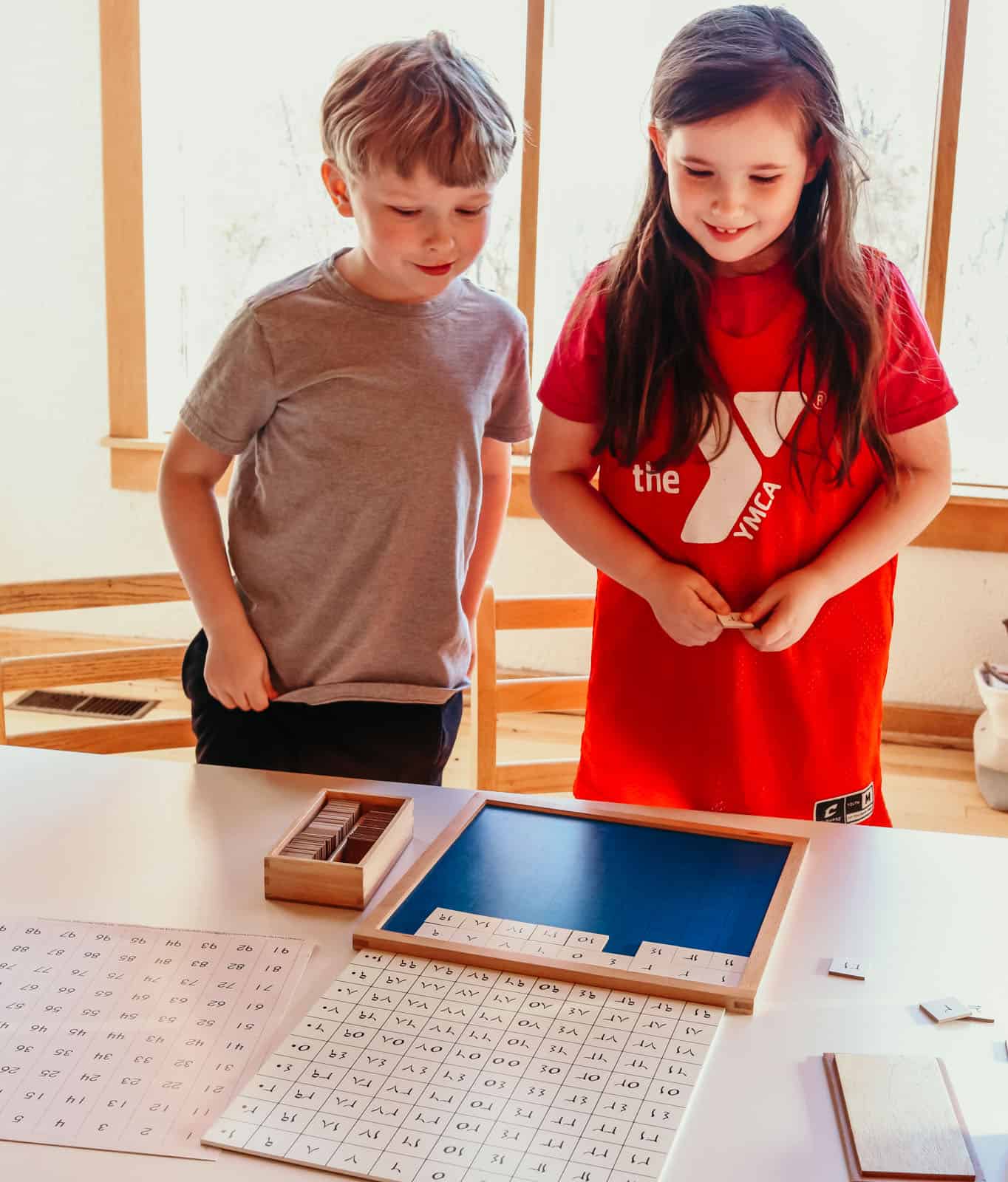
There were a lot of interesting discussions while working with the Arabic hundred board tiles and excitement as they were able to successfully place each row of tiles on the board. We're going to follow this up with a related art activity in the future.

Skip Counting Puzzle
This is another activity by Montessori Living Room's Classic Cars. The printable includes several of these skip-counting puzzles. The kids enjoy doing them independently and together. This was a really fun extension to the History of Numbers.
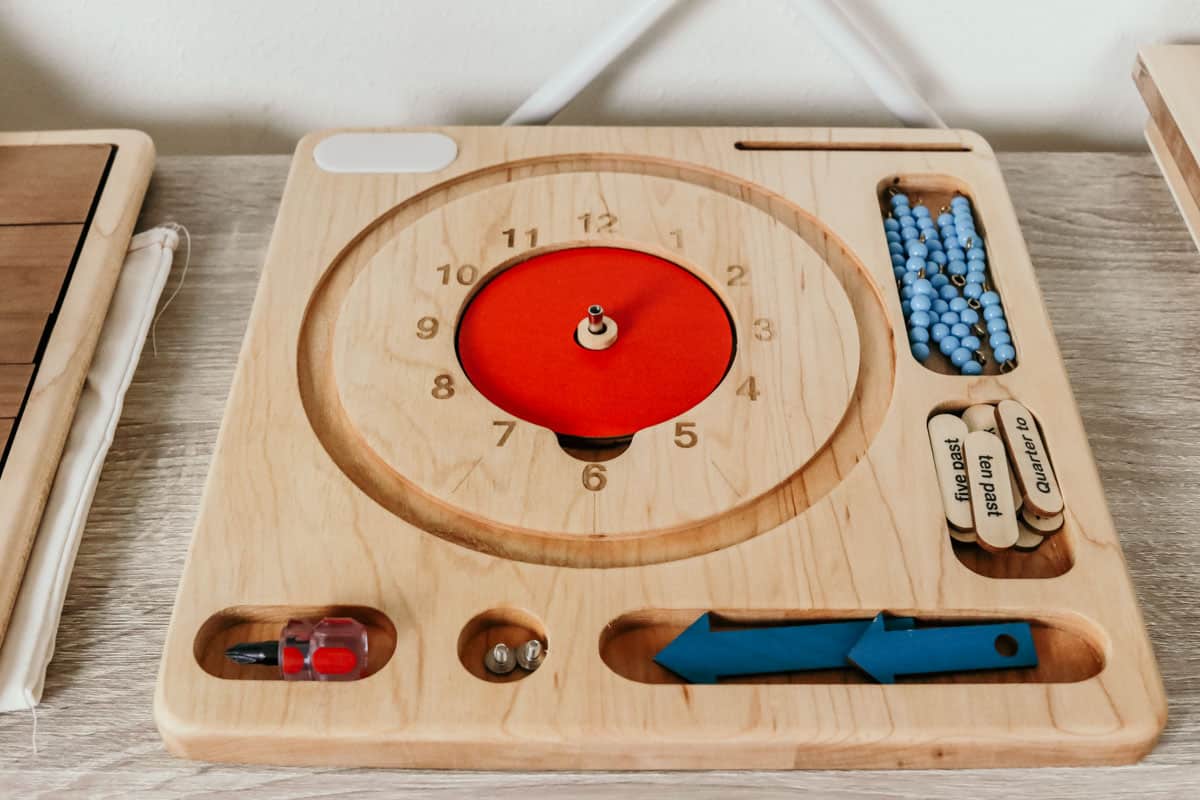
Montessori Clock
A Montessori teaching clock will teach kids several concepts related to numbers and time.
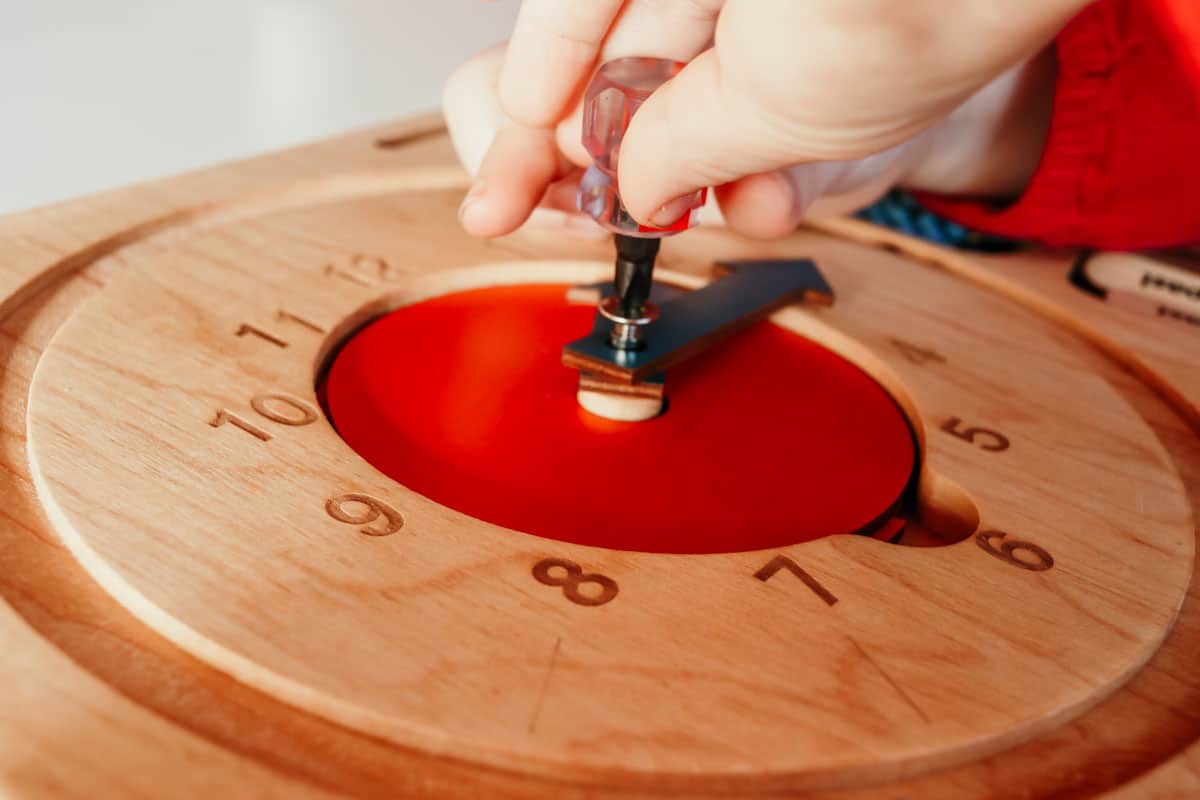
Kids can use the screwdriver and screws to add the hour and minute hands to the clock, like a real clockmaker or inventor, while working on fine-motor skills.
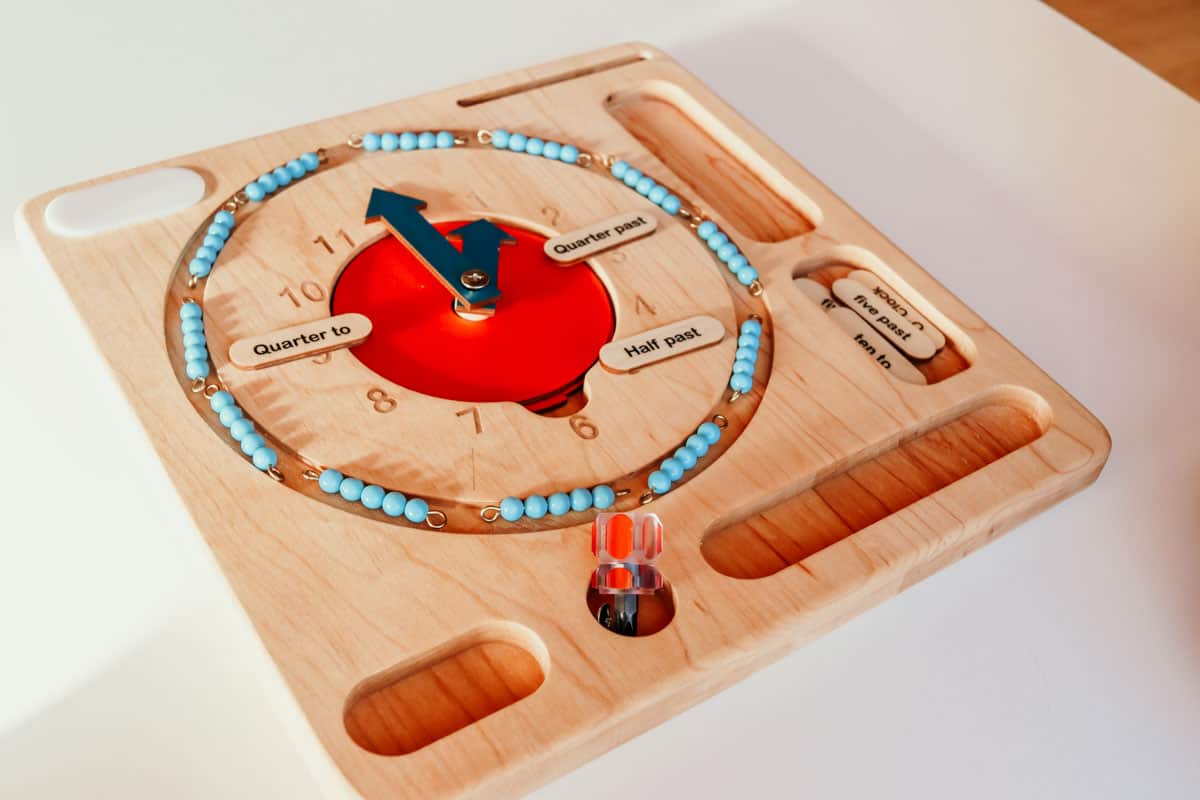
The blue five beads are used to count by 5's as kids learn how to count the minutes in an hour. They are placed in the groove surrounding the clock as you give the lesson and then while kids are practicing afterward.
Once kids are able to tell time using this teaching clock, the labels provide common terminology related to telling time such as quarter to, ten past, etc.
The removable red fraction insets are helpful for exploring fractions of time or fractions in general, such as quarter, half, whole, etc.
The whiteboard at the top can be used to transcribe the time in a digital format.
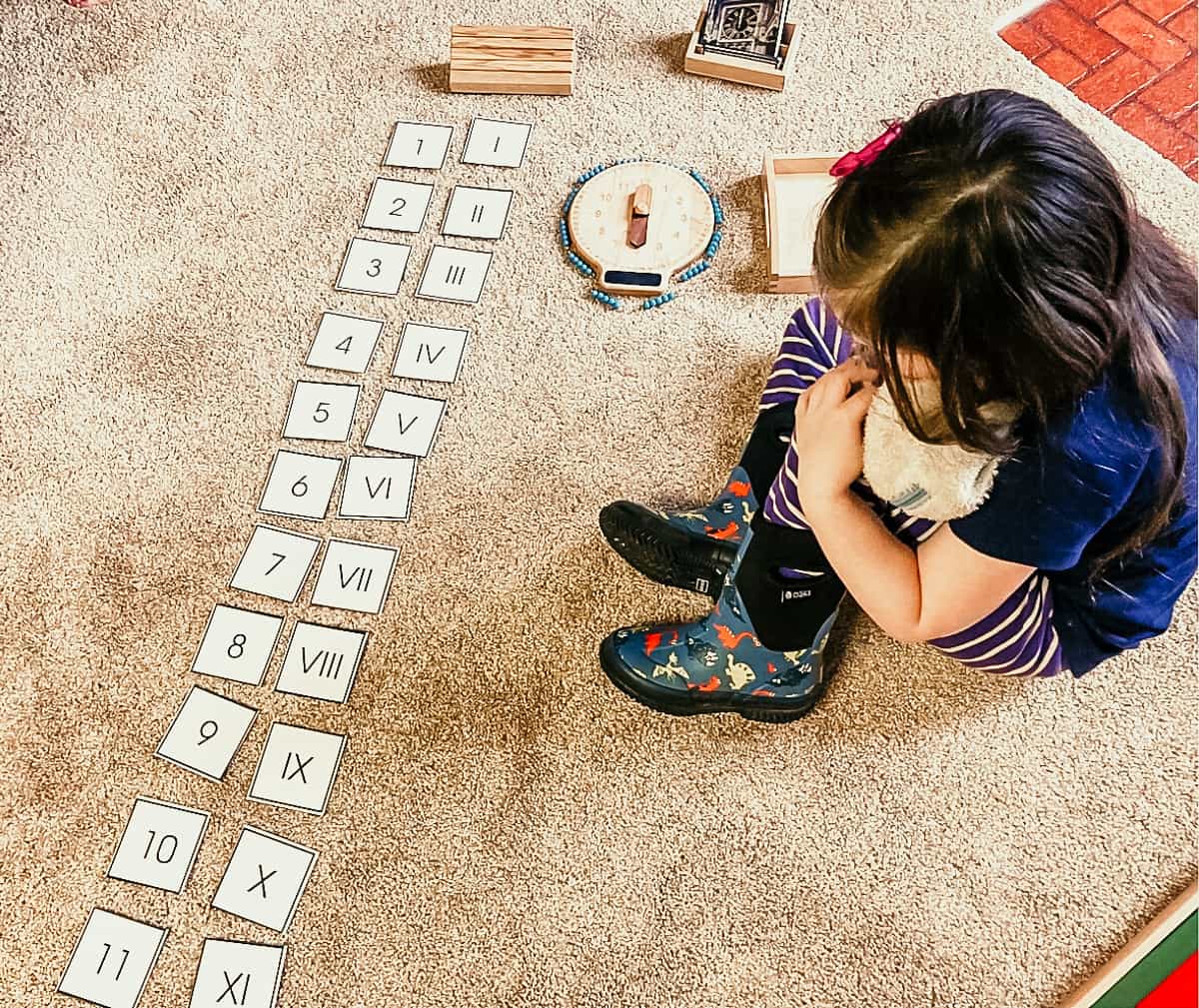
Roman Numerals and Telling Time to the Minute
Kaia used this Montessori Telling Time: Roman Numerals printable pack to match Numbers and Roman Numerals. Next, we reviewed telling time to the minute using the colored beads and her Montessori Learning Clock by Mirus Toys.
The 5 bead bars fit perfectly around this Learning Clock to illustrate counting the minutes and it's also a great way to practice skip counting by five.
The Roman Numeral printable bundle has several activities included and it's great for offering various activities to reinforce knowledge of time and Roman Numerals.
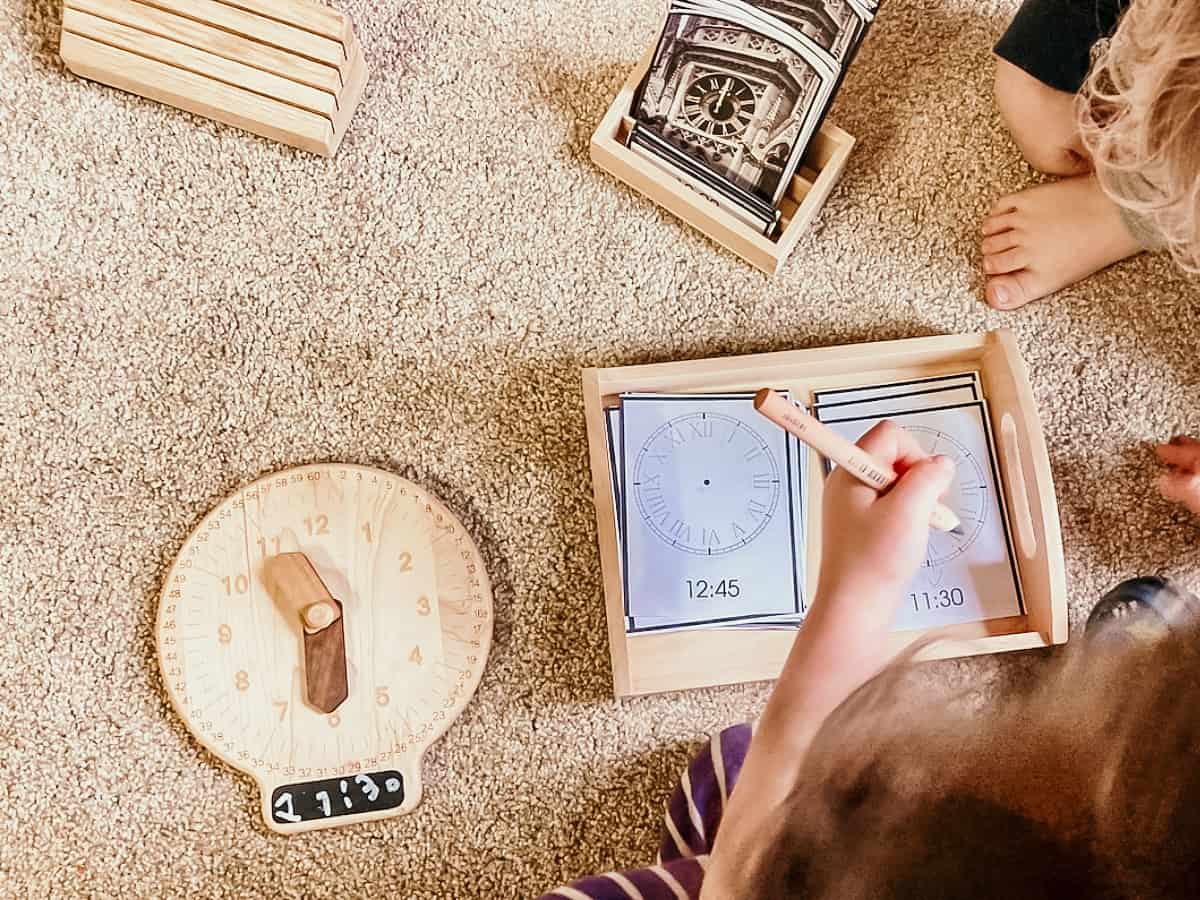
Recording Time on a Roman Numeral Clock
The Montessori Learning Clock was used to practice building the time that was written as a digital timestamp on each Roman Numeral Clock Card. Kaia wrote the time on the Learning Clock and adjusted the hands on the clock. Finally, she recorded her answer on the Roman Numeral Clock Card.
This History of Numbers activity is great for practicing time to the minute while reinforcing knowledge of Roman Numerals.
Noah uses the clock to practice time to the half hour and enjoys learning from his sister how to read and write time to the minute.
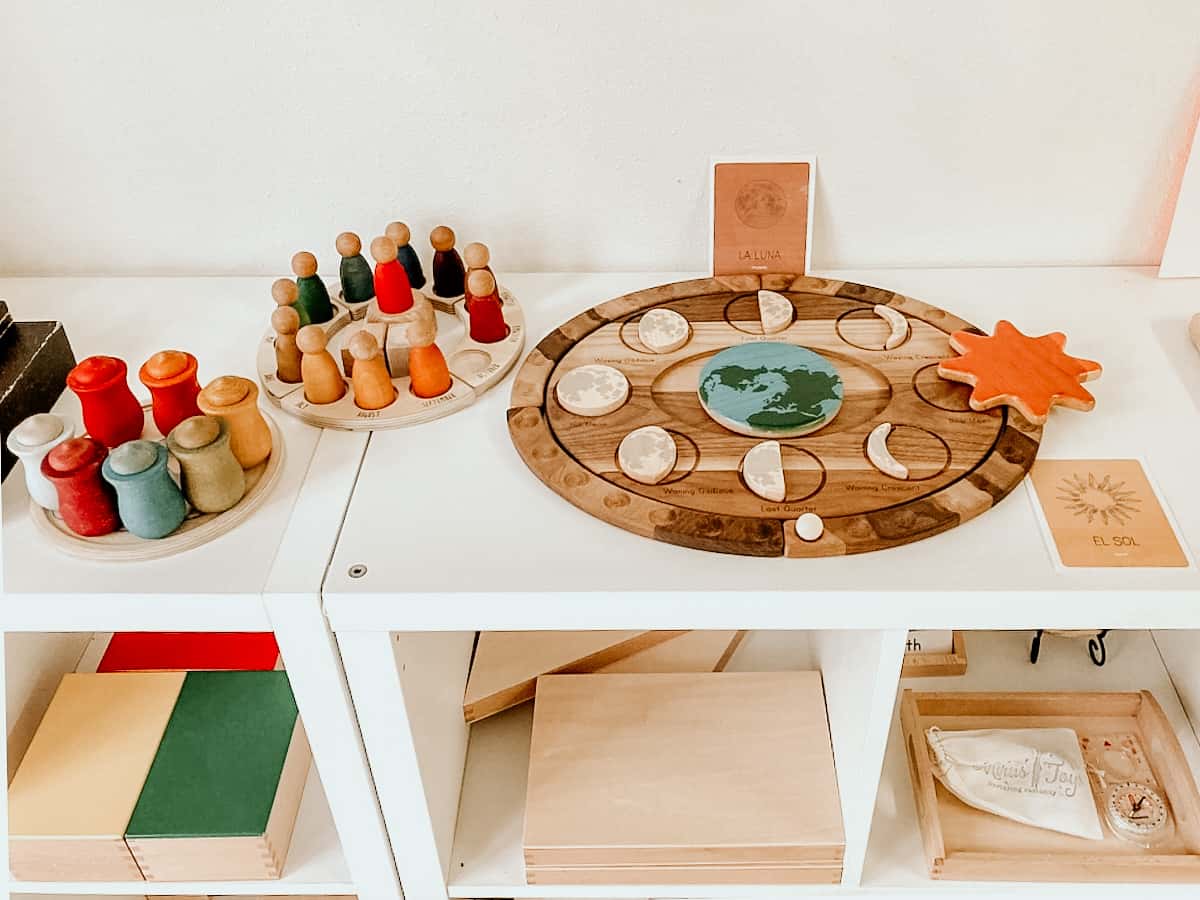
Calendars
We really enjoy having these perpetual calendars to keep track of the day, date, and moon phase. We also have a linear calendar whiteboard but we've found that these calendars are best for introducing children to the rhythms of nature.
The kids' Daily Visual Calendar is really helpful for assisting them in their independence with our Daily Rhythm.
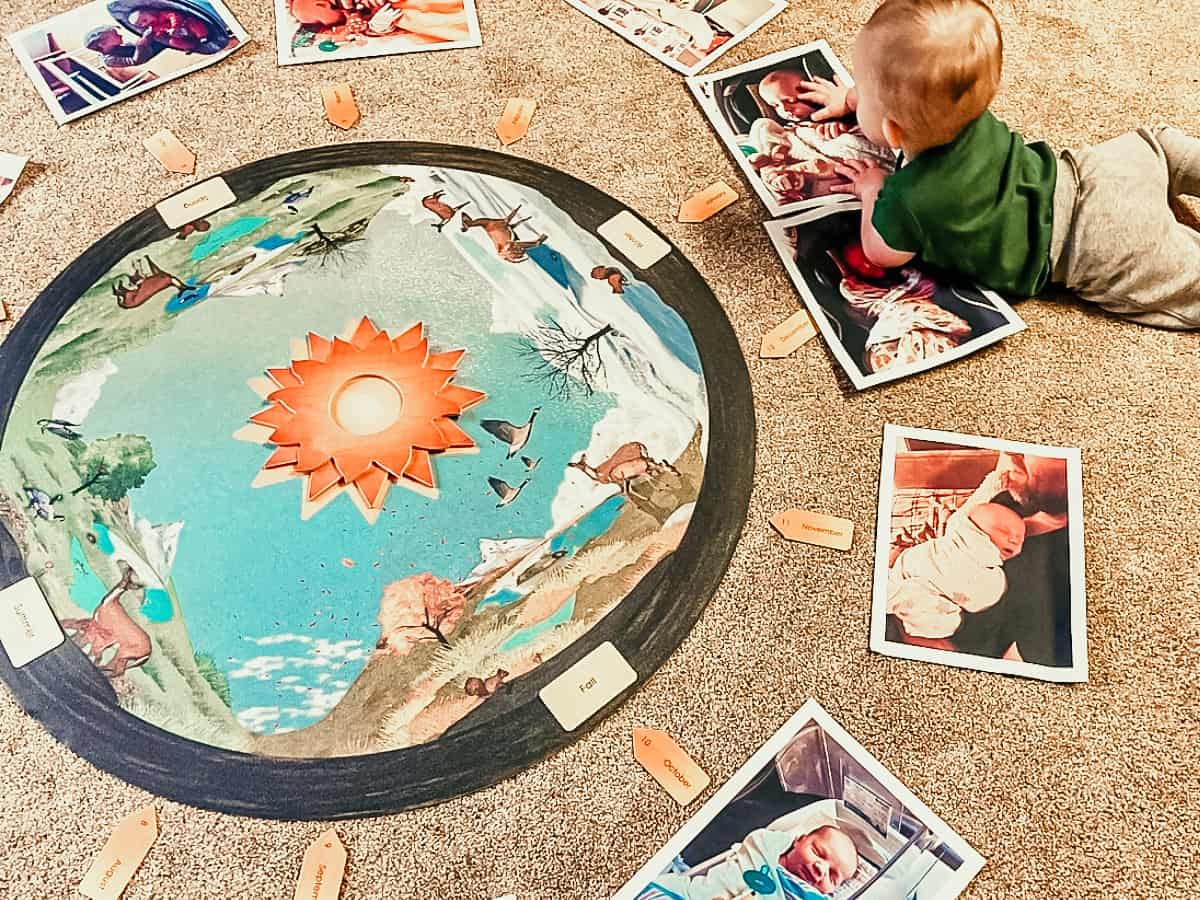
Seasons of Life
If you follow us on Twitter, you know we celebrated our son's first birthday with this mat. It is the Waseca Biomes Seasons Mat and we used it for the Montessori sun celebration.
It's awesome to be able to use it for a child's first birthday. Having pictures for each month of the year allows the children to really see the remarkable growth and development that takes place during the first year of life. Such a great experience for all.
We also use this mat for studying the seasons.
Save $15 on your first Waseca Biomes purchase here.
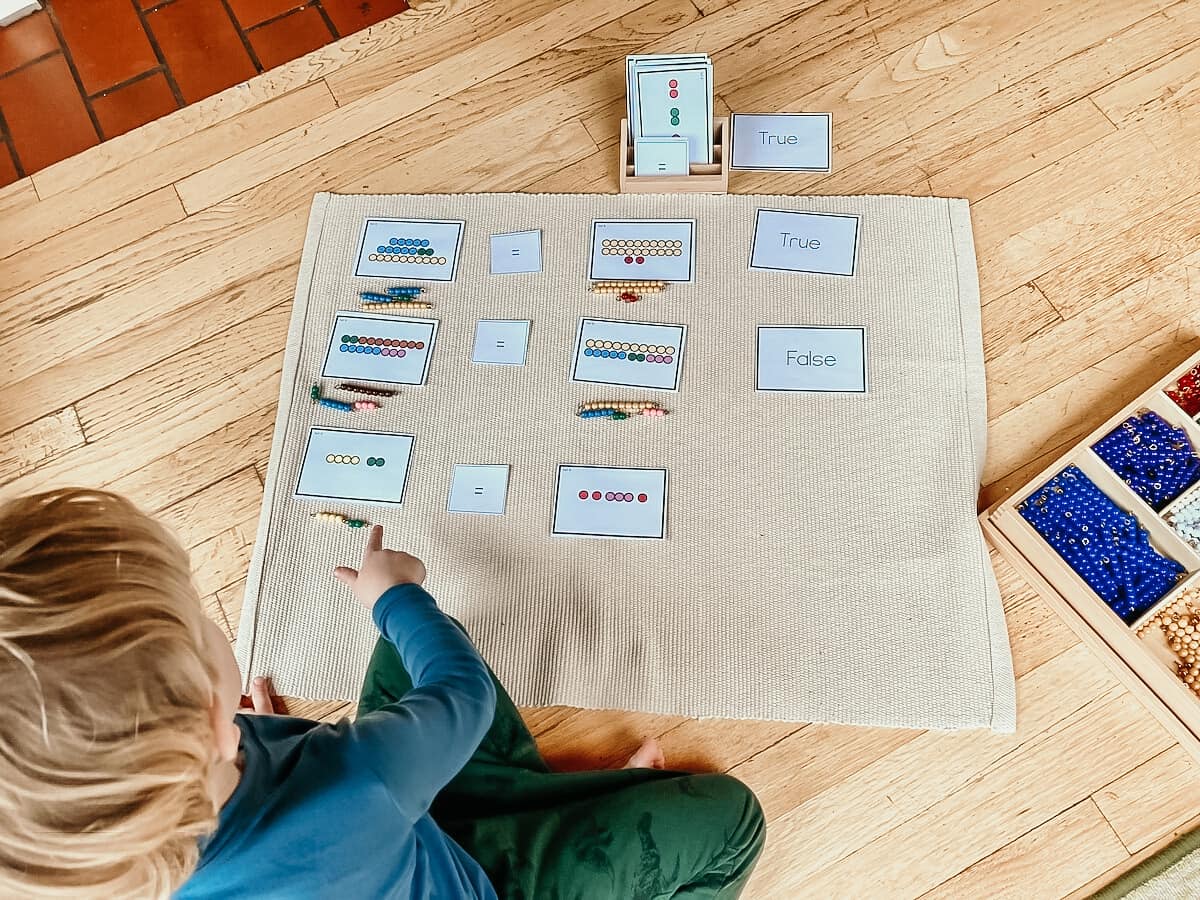
Equivalence Equations
We used this Balancing Equations printable to explore equal amounts up to 20.
Get 16% off your purchase from Montessorikiwi here.
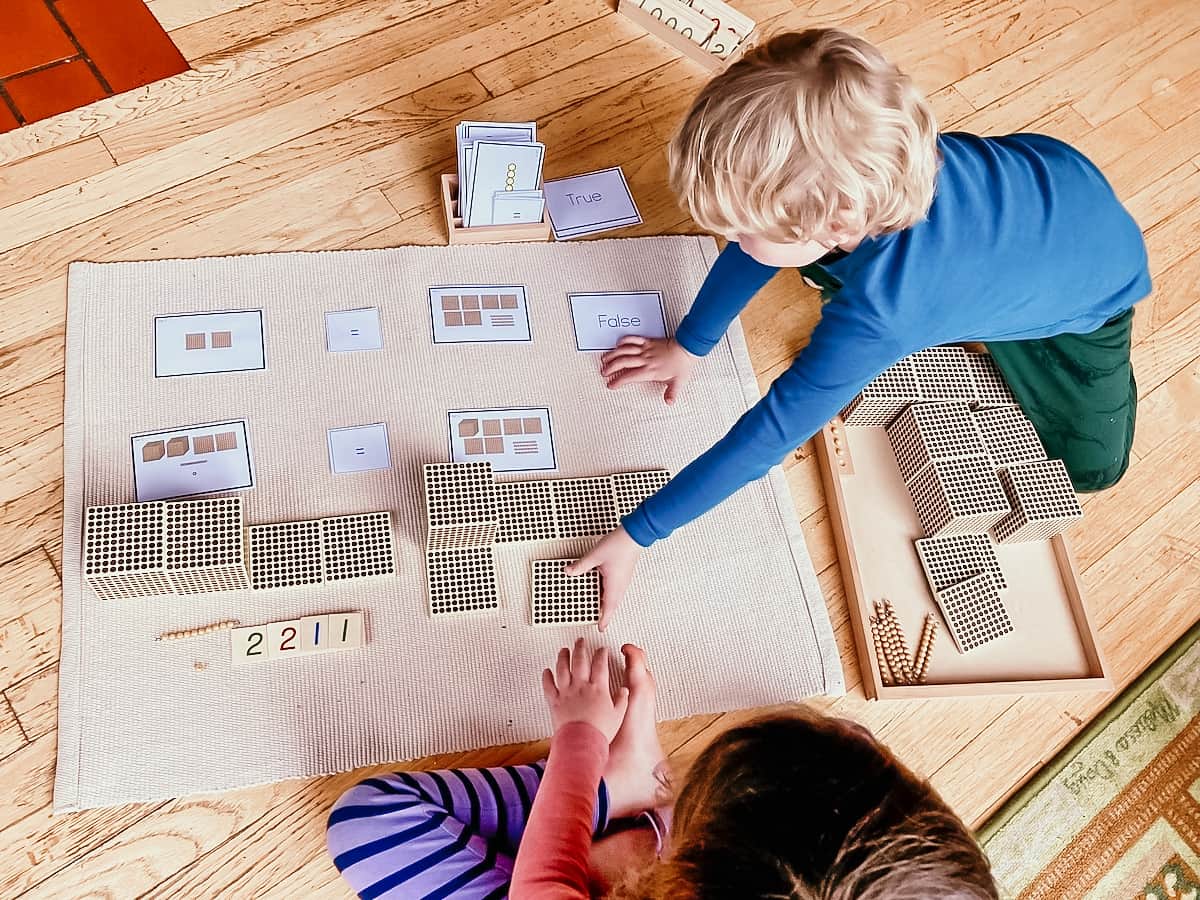
Balancing Equations with Large Numbers
We used this same Balancing Equations printable to explore equal amounts in the thousands. The kids really like this activity because they can each do the first two sets of equations independently and Noah is now able to help Kaia fetch the appropriate Golden Beads for the third set of equations.
Kaia then shows him how she uses the numeral cards to do the magic slide, identify the value, and state the value.
Get 16% off your purchase from Montessorikiwi here.
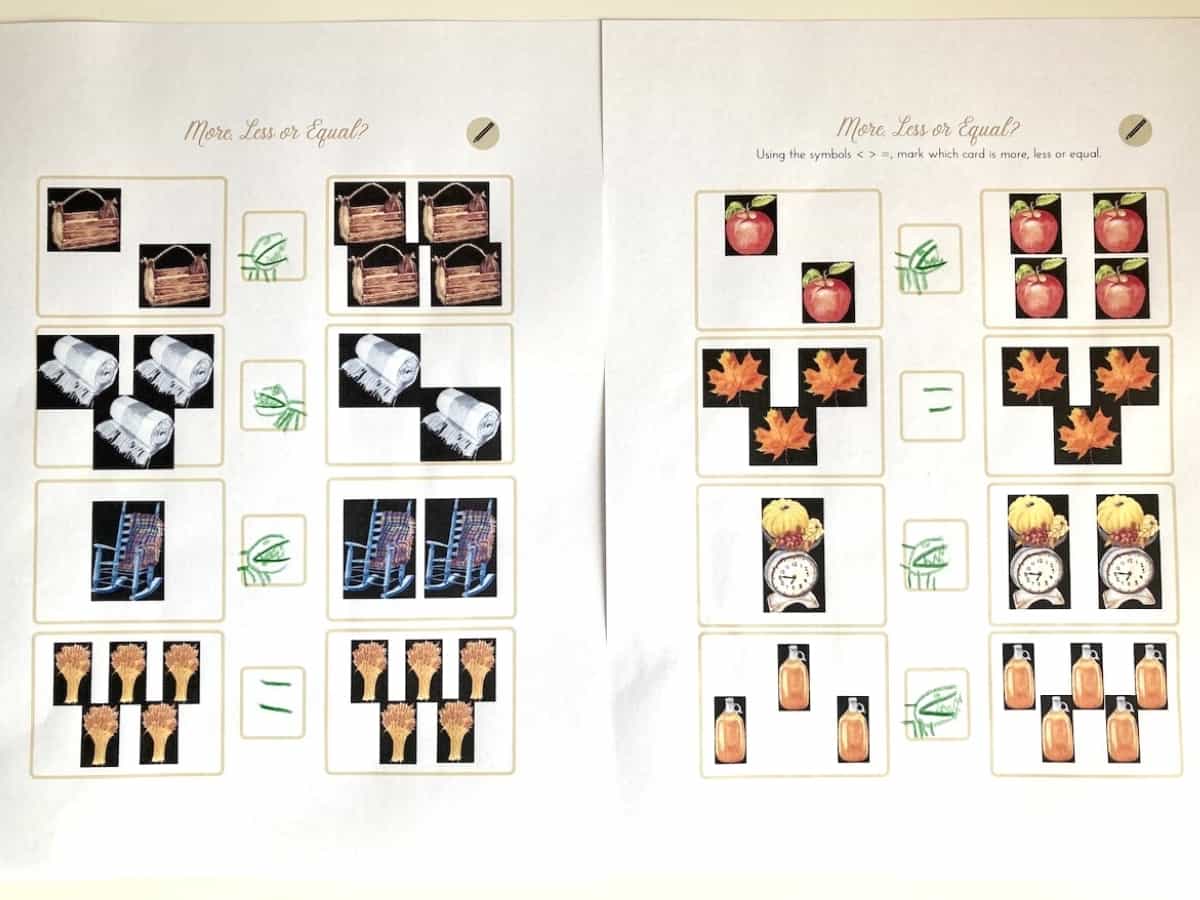
Greater Than, Less Than, Equal
We used this same Autumn printable bundle from our Montessori Fourth Great Lesson to learn about More, Less, or Equal. I accidentally printed it incorrectly so the images have black boxes around them. Fortunately, Kaia didn't mind and she happily drew alligators all over as she practiced her math skills with Noah.
When introducing this as Montessori-aligned shelf work, the boxes can be cut out and placed on a tray for matching before the child draws the appropriate sign for each blank box. A control of error could be having the answer on the back of the blank boxes.
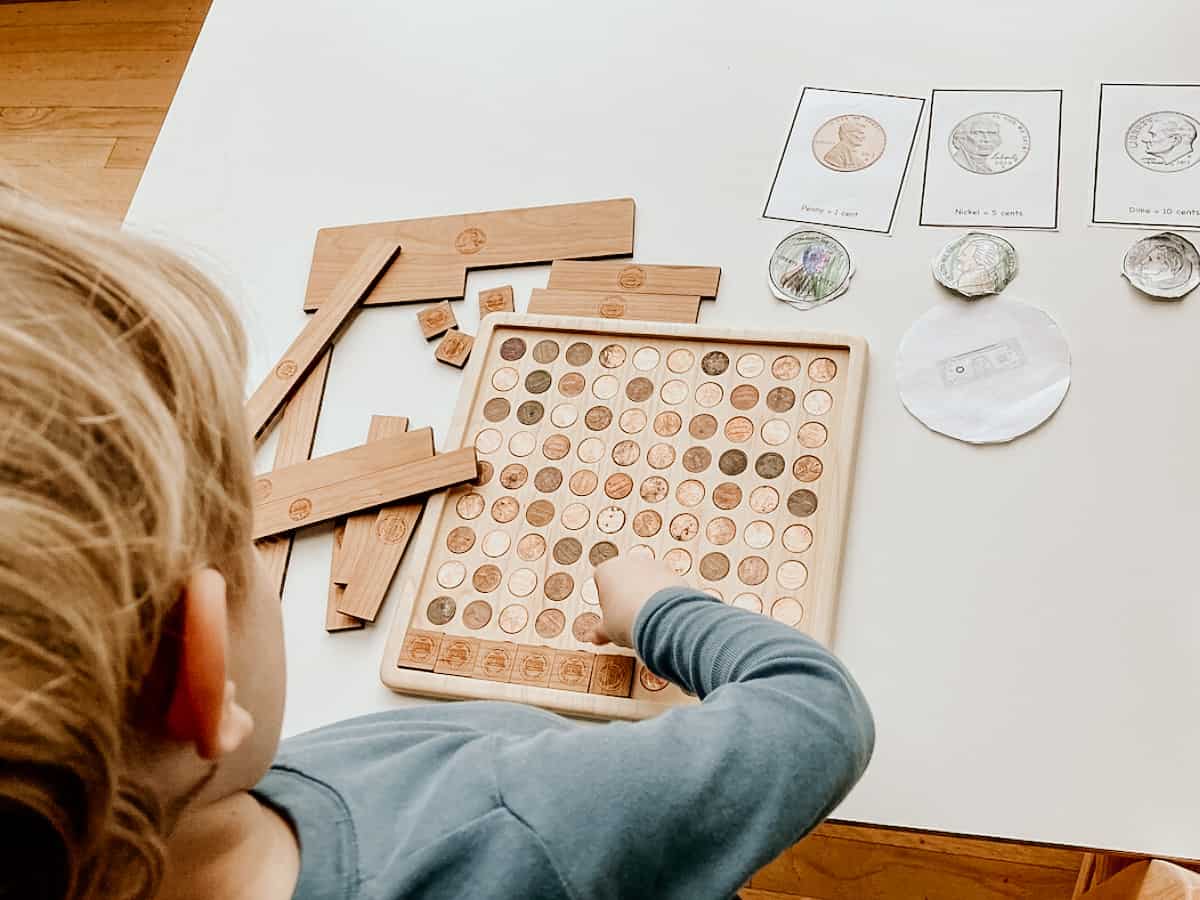
Money
This Dollar Counting Board by Mirus Toys is always a huge hit with the kids for exploring money, coin values, and adding change up to a dollar. Noah likes to compare the board with these U.S. Currency Nomenclature cards and the coins he made from this U.S. Coins Printable Activity Bundle.
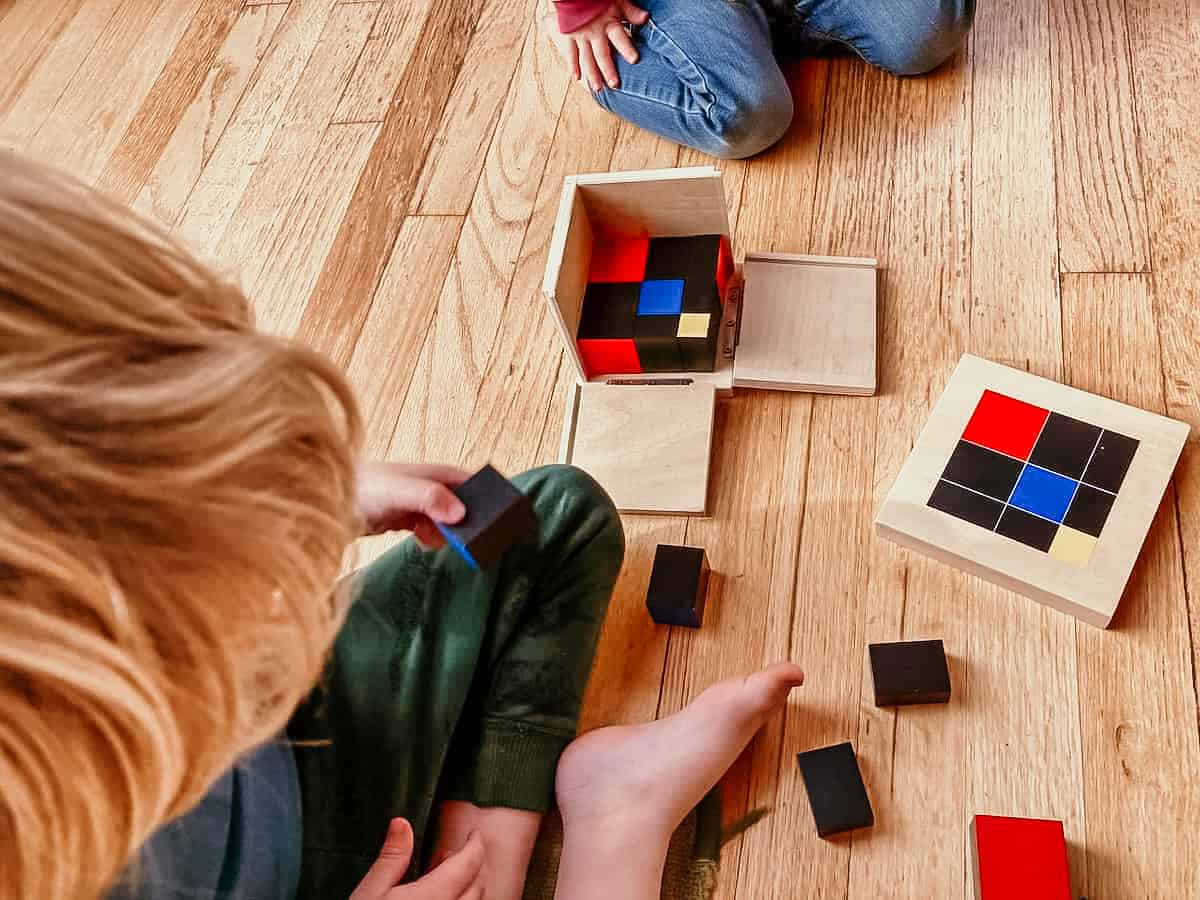
Montessori Trinomial Cube
The kids really like working with the Trinomial Cube. Katalina is a bit young for it but she loves to stack the pieces just like her brother and sister. Also, Noah gets really excited every time he adds the very last block to the cube. So much fun.
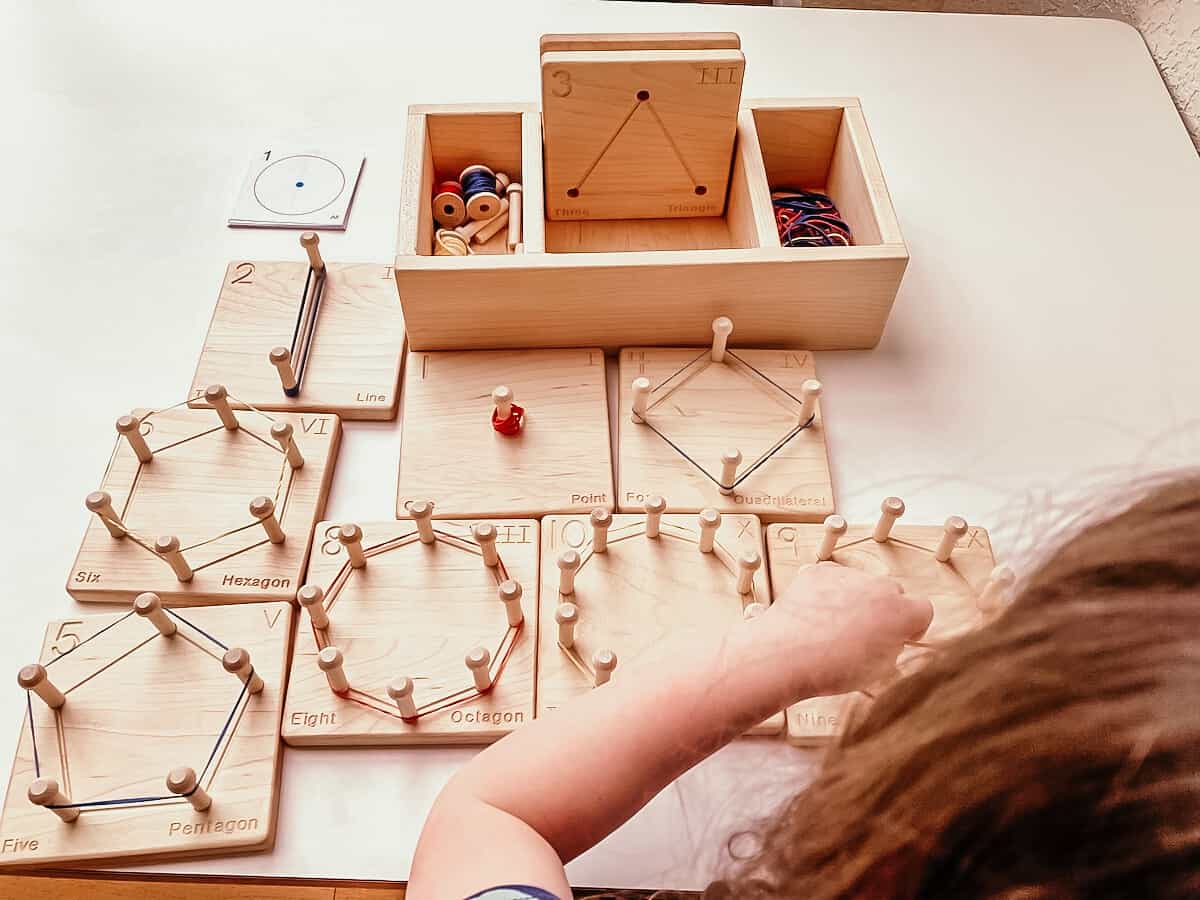
History of Numbers: Roman Numerals and Geometry Cards
Kaiai and Noah are really into these Geometry Cards. They are perfect for reinforcing Roman Numerals while exploring shapes, skip counting, patterns, and more. I love that it comes with a very thorough guide that includes guidance on several activities.
Kaia really likes wrapping the colored yarn around the pegs while she practices skip counting. Noah likes using rubber bands to create shapes and choosing different ones based on their elasticity.
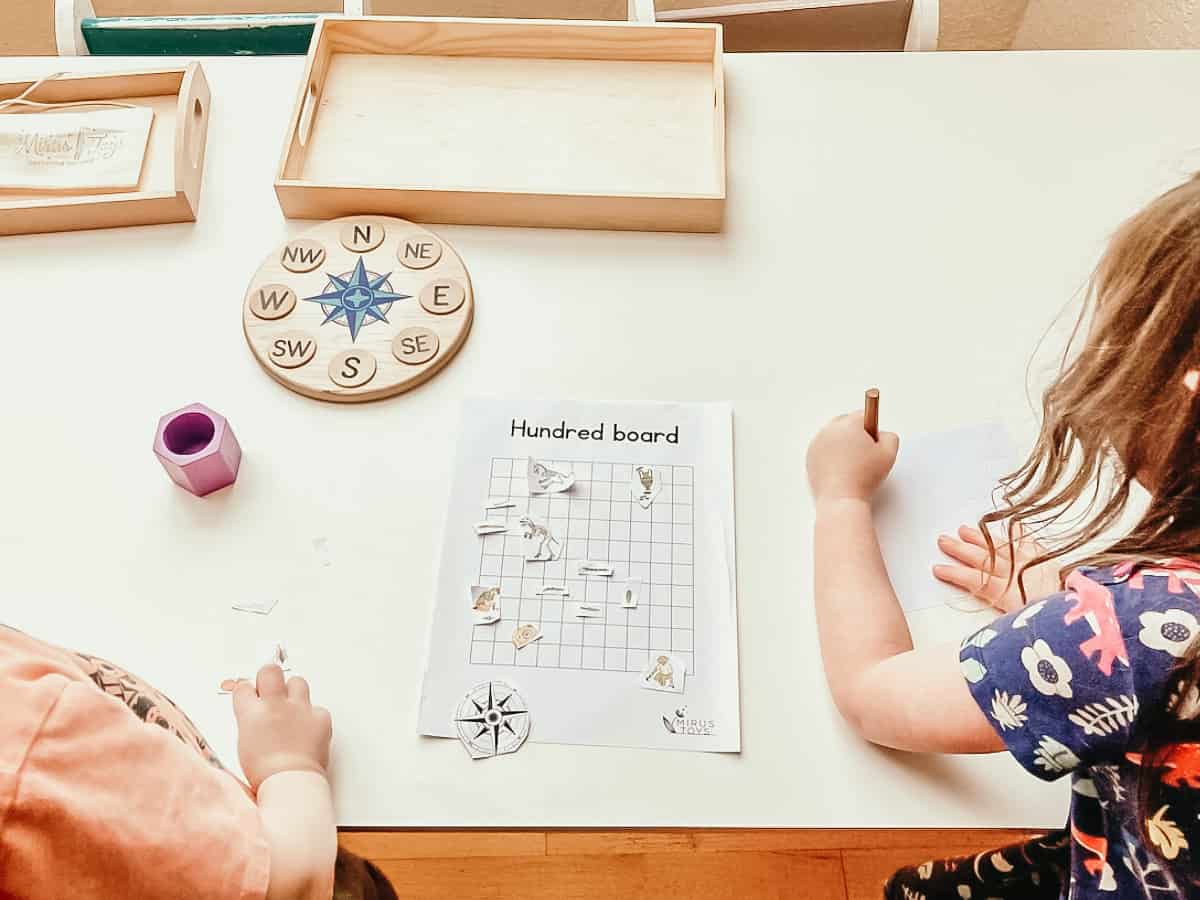
History of Numbers: Hundred Board Treasure Map
This Compass Rose Puzzle's Hundred Board Treasure Map comes with the puzzle and it's such a great way to practice directions and counting while immersing yourself in the adventure of a treasure hunt.
The kids each placed a character and some treasures on the map. Next, they identified how many steps in each direction it would take to reach their desired treasure. Finally, our oldest recorded it on a sheet of paper.
We used the Compass Rose Puzzle a lot during our Montessori Fourth Great Lesson and it's still getting a lot of use as we explore Math.
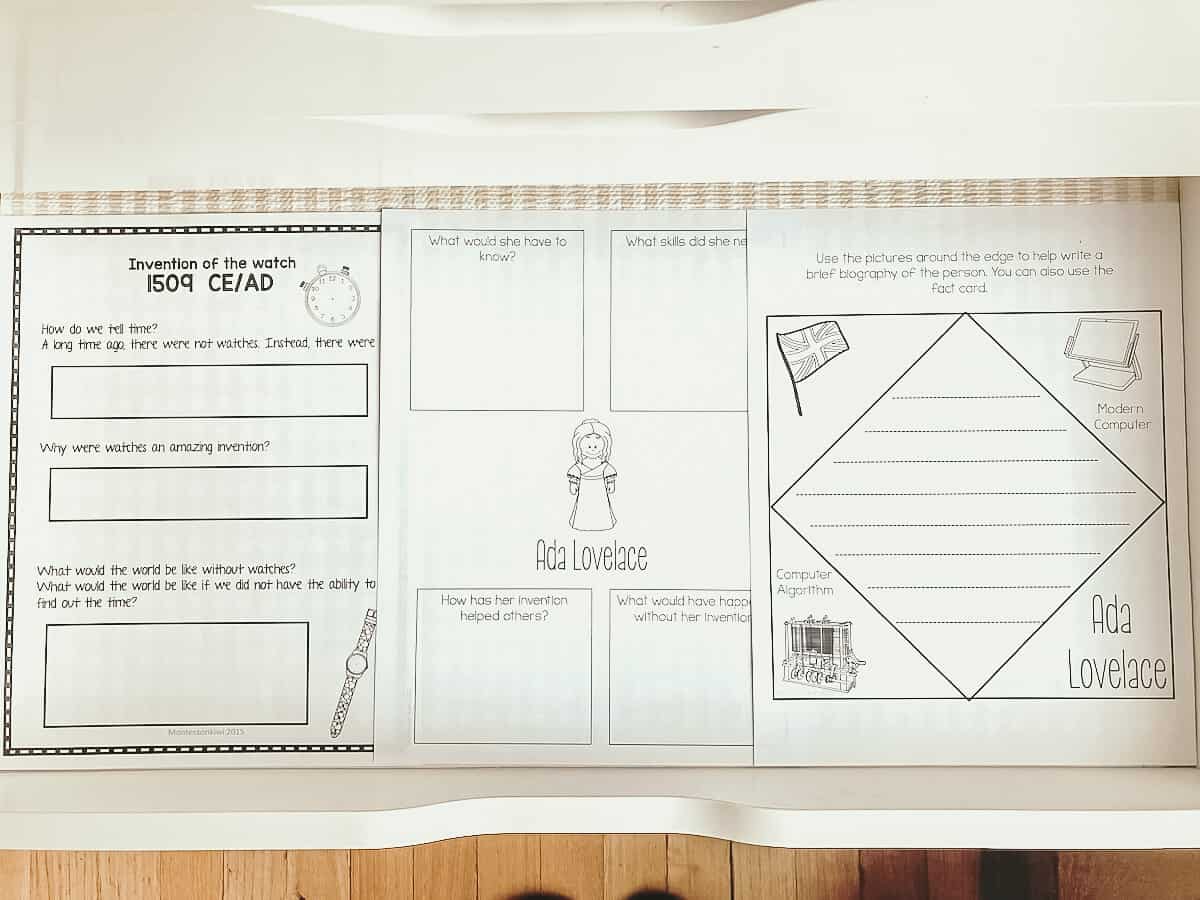
Mathematicians and Inventions in the History of Numbers
These printables are from our Timeline Cards and the Inventors and Inventions printable from our Montessori Third Great Lesson and we revisited them for this lesson. The kids love their Math Books and these printables are a great follow-up work for our oldest.
Get 16% off your purchase from Montessorikiwi here.
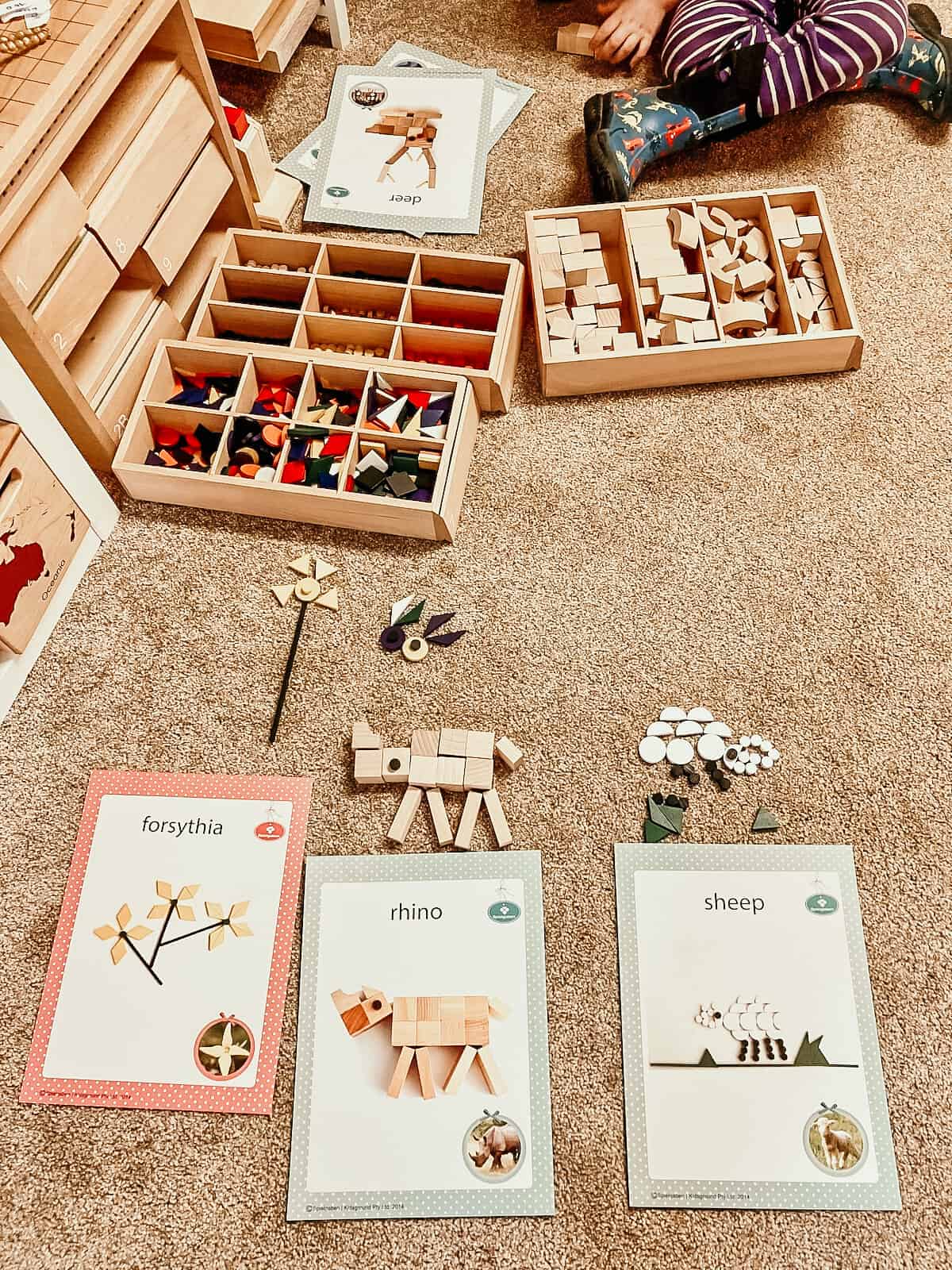
History of Numbers: Spielgaben Shapes in Nature
This is the kids' go-to activity when they want to spend a couple of hours exploring shapes and building things. Sometimes they like to follow these Spielgaben nature inspiration cards and other times they're building purely from their imagination.
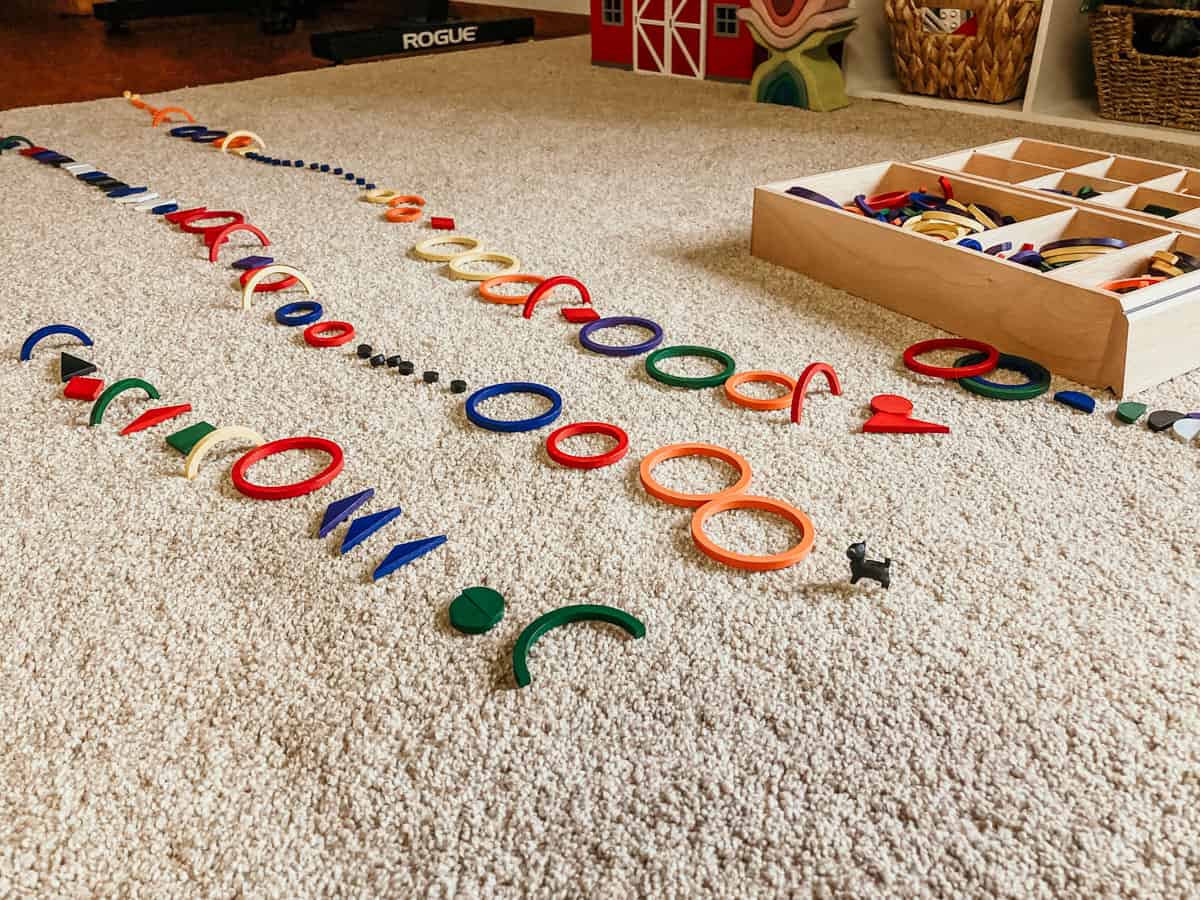

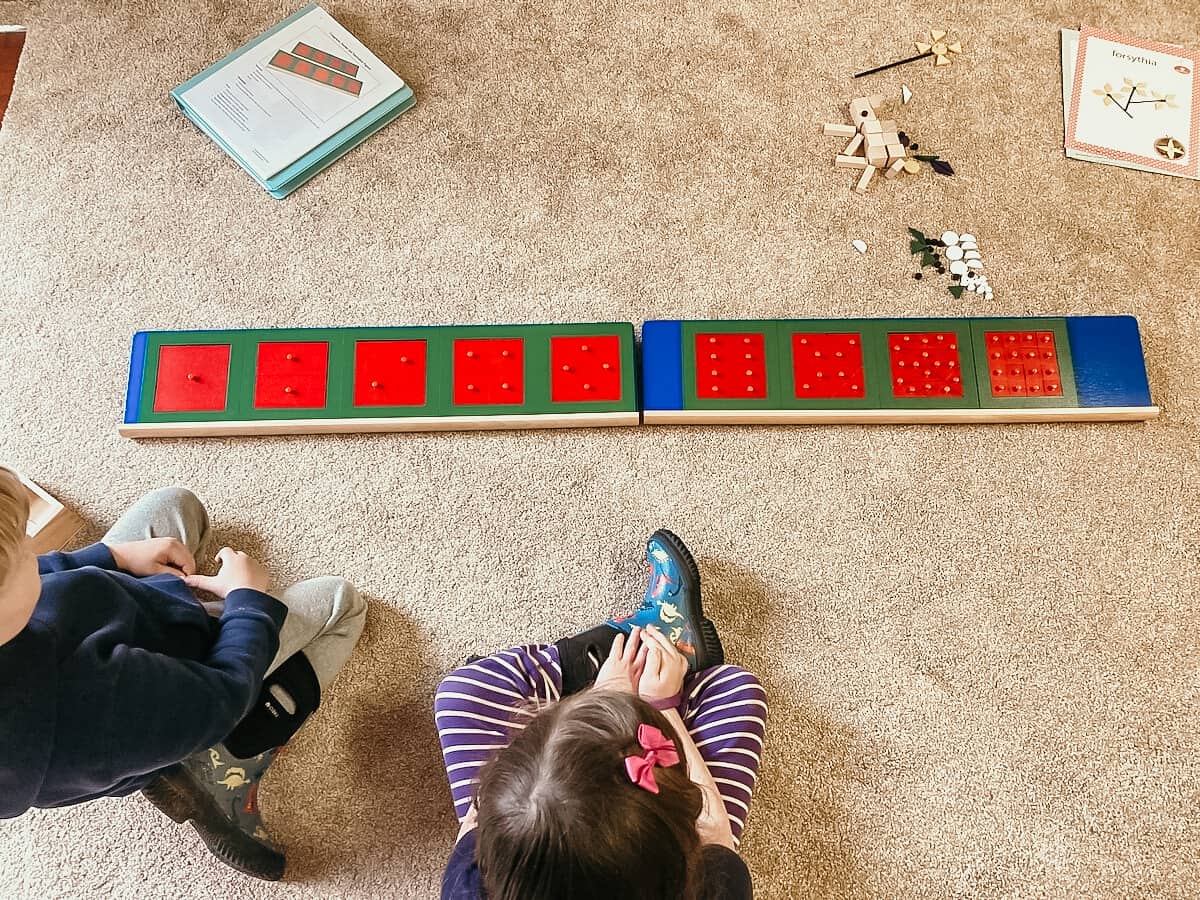
Congruent, Similar, and Equivalent Figures Using Square Insets
We used these Square Insets to explore congruent, similar, and equivalent figures. I used the FREE Cultivating Dharma Geometry Album from our Montessori Elementary Curriculum resources to deliver the lesson and it worked out well.
Noah was playing with the Spielgaben and came over to see what we were up to. I didn't think it would resonate with him but he hung right in there and took out the correct square insets as we went through the lesson. It seemed like he enjoyed it.
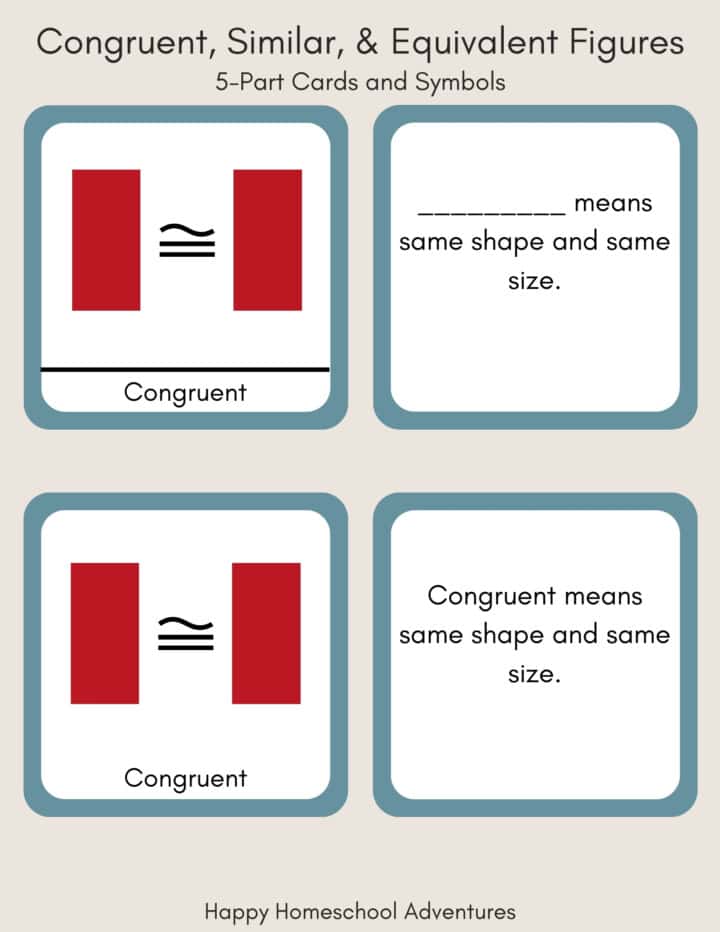
Free Congruent, Similar, & Equivalent Figures
5-Part cards to master geometry concepts
Free Congruent, Similar, & Equivalent 5-Part Cards & Symbols
Grab your free 5-part cards and symbols for exploring congruent, similar, and equivalent figures. This printable activity was inspired by and can be used in conjunction with the free Montessori geometry album we use.
After giving the lesson on congruent, similar, and equivalent figures, kids can work with the 5-part cards as they cement their understanding. The associated symbol cards can be used in practice. The symbol card with text will be most helpful as children are learning the vocabulary. Afterward, they can progress to the cards without the text.
This free printable works well square insets, fraction circles, constructive triangles (below), or any other materials you use to demonstrate the concepts.
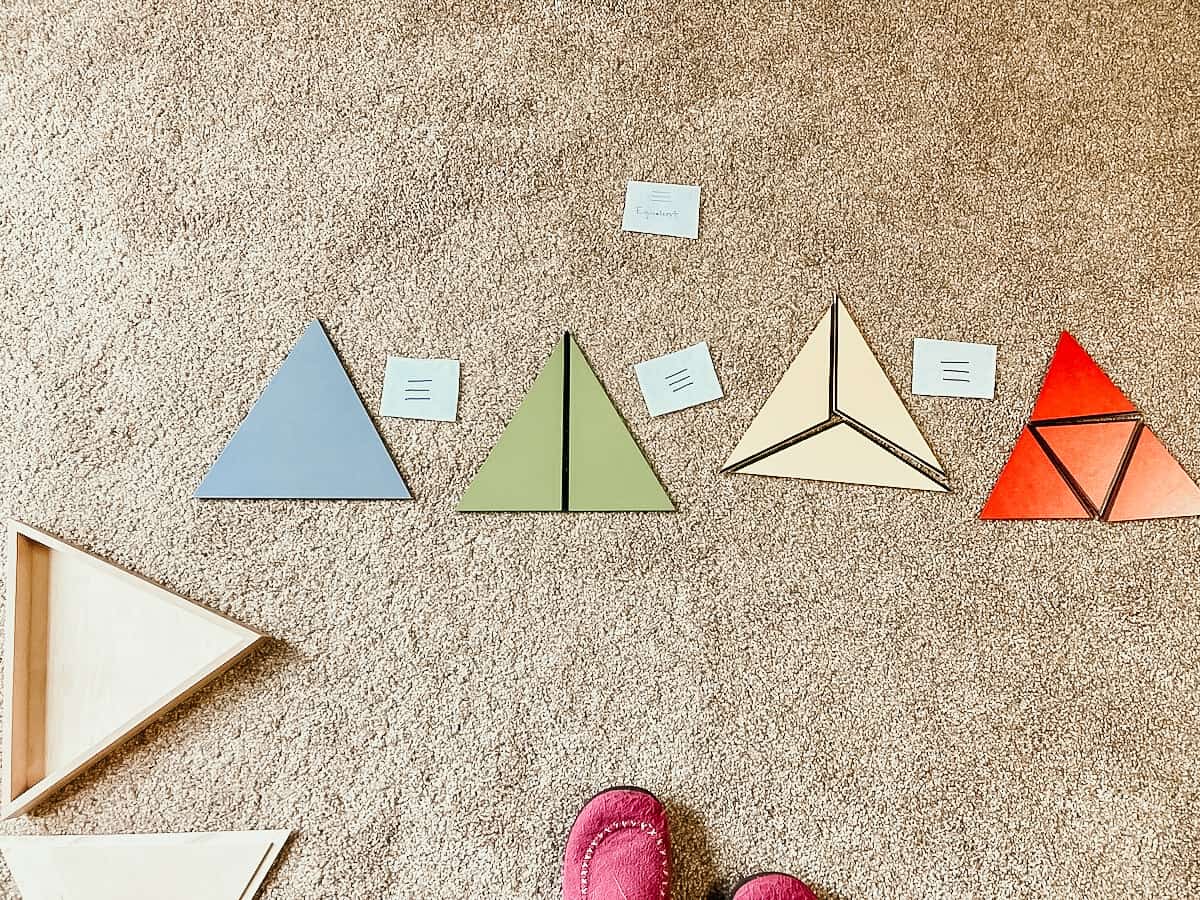
History of Numbers: Equivalent Triangles
I used the same Cultivating Dharma Album to deliver the equivalent triangles lesson along with the triangle box from the Montessori Constructive Triangles.
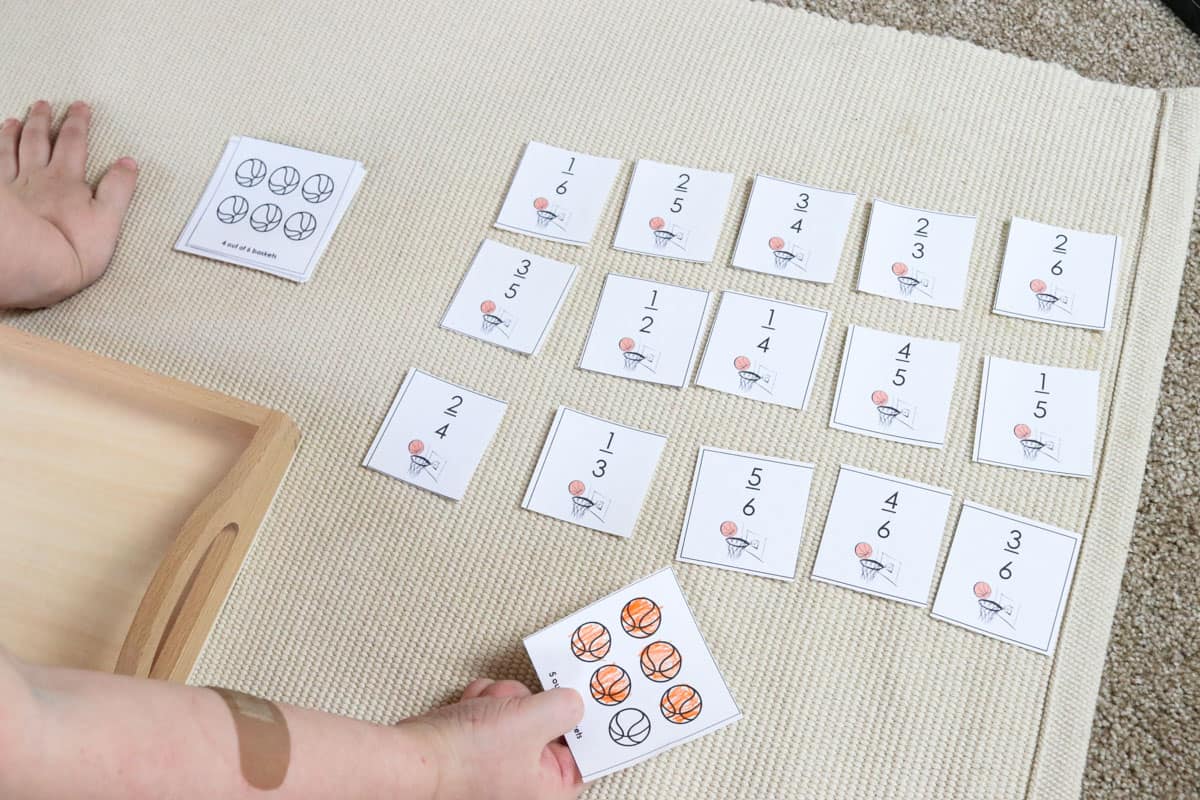
Fractions
The March Madness Math Printable Pack also includes fraction work.
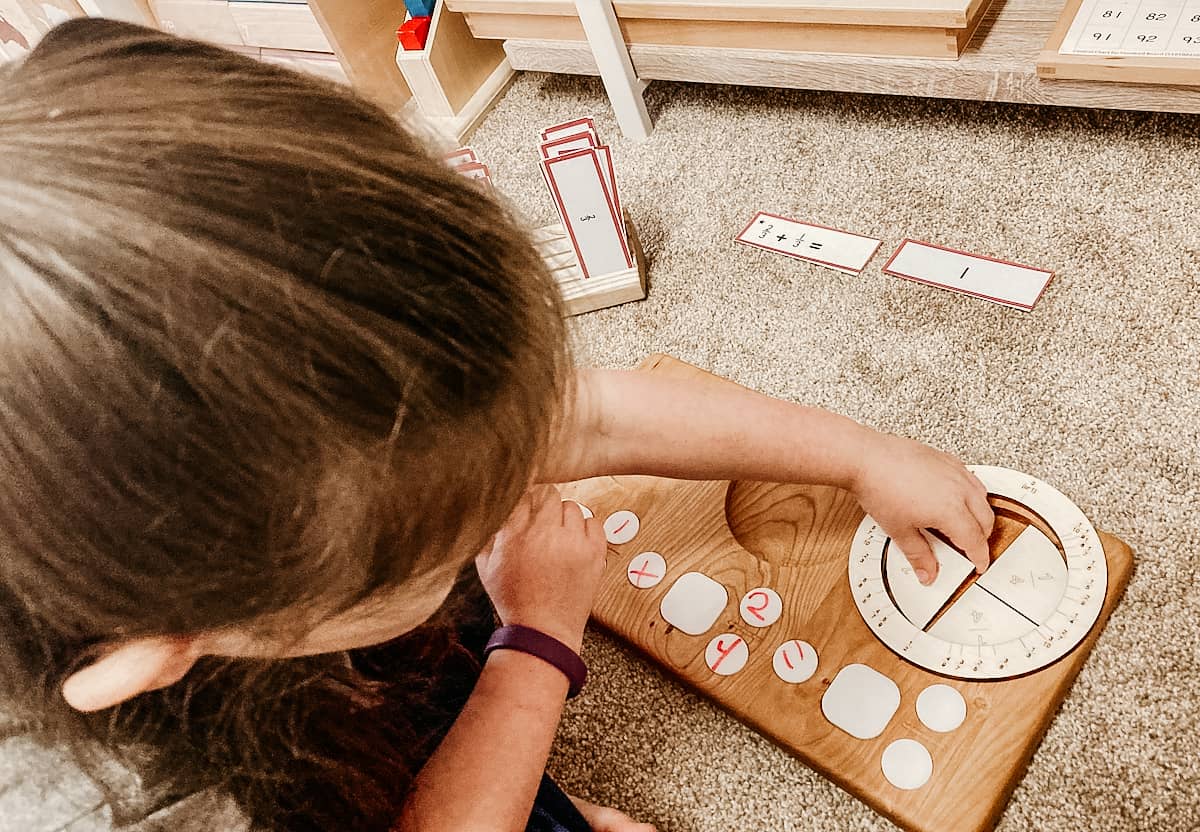
Fraction Addition
Kaia uses this Mirus Toys Fraction Manipulation Board and these Fraction Addition Tickets to practice adding fractions. She loves that she can write on it with a dry-erase pen and use the fraction ring as a control of error.
Get 16% off your purchase from Montessorikiwi here.
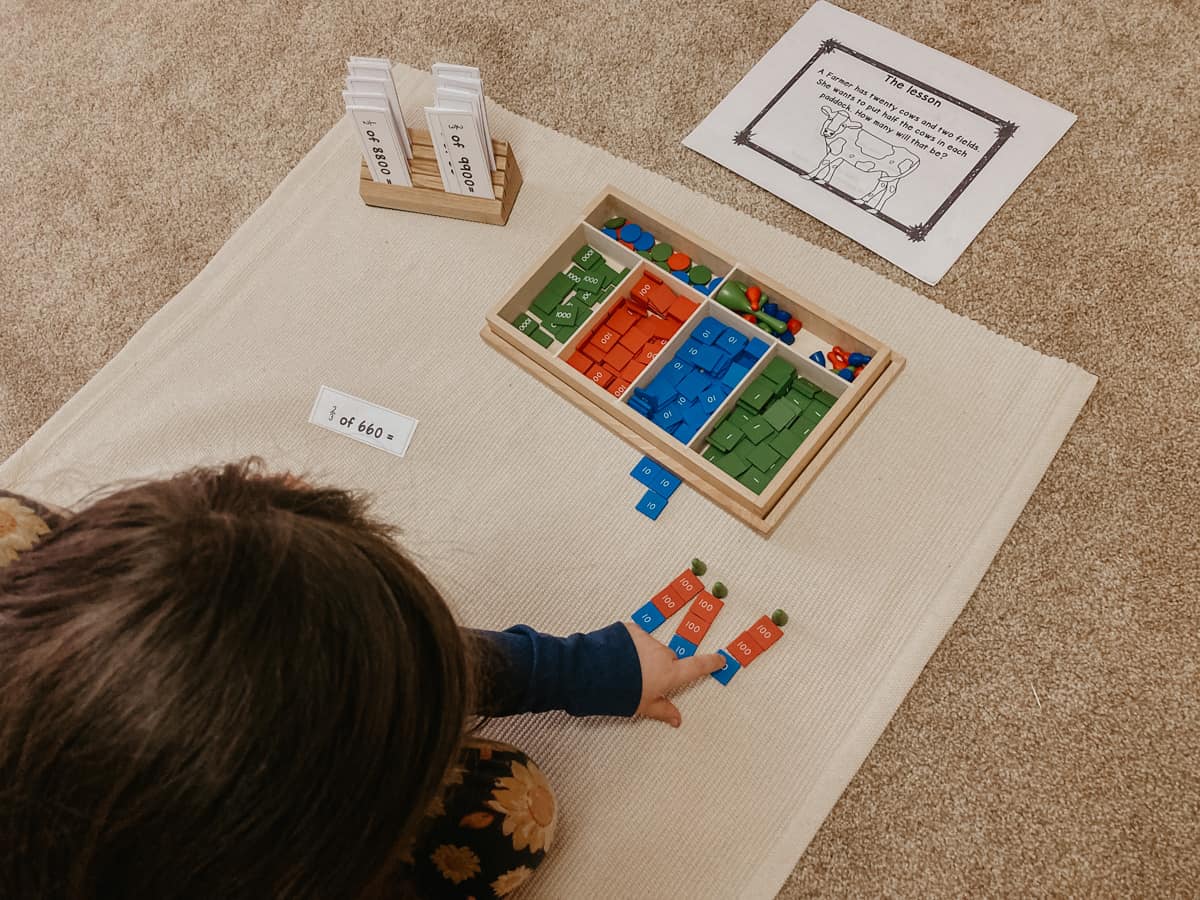
Fractions of an Amount
If your kids like animals & have explored fractions, this Montessorikiwi Fractions of an Amount activity with cows is a must-have. Kids can solve for amounts such as ½ or ⅔'s of the cows in separate paddocks with the Montessori stamp game.
Get 16% off your purchase from Montessorikiwi here.

free NBA game!
What's Their Average?
Calculate the average for each NBA player.
Free NBA Averages Word Problems
Use the Montessori stamp game to calculate the averages described in each word problem. Kids can check their answers to see how they did. All answers are in whole numbers. There are no decimals in this printable. Simply cut out the question cards and place them on the shelf next to the Montessori stamp game for easy access.
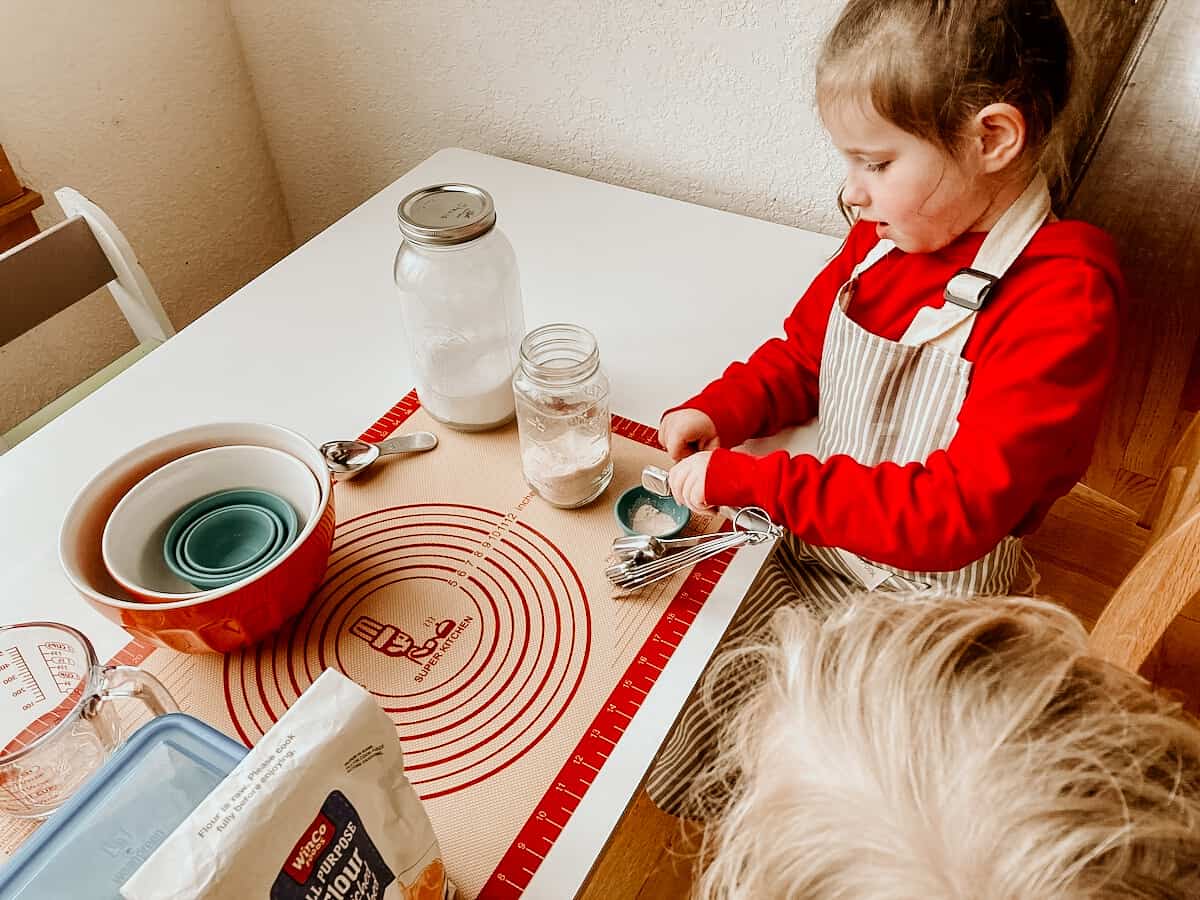
History of Numbers: Pan de Muerto and Measurements
The kids followed this recipe for Pan de Muerto or Bread of the Dead while practicing their measurement skills. You can find more measurement activities in this Second Great Lesson.
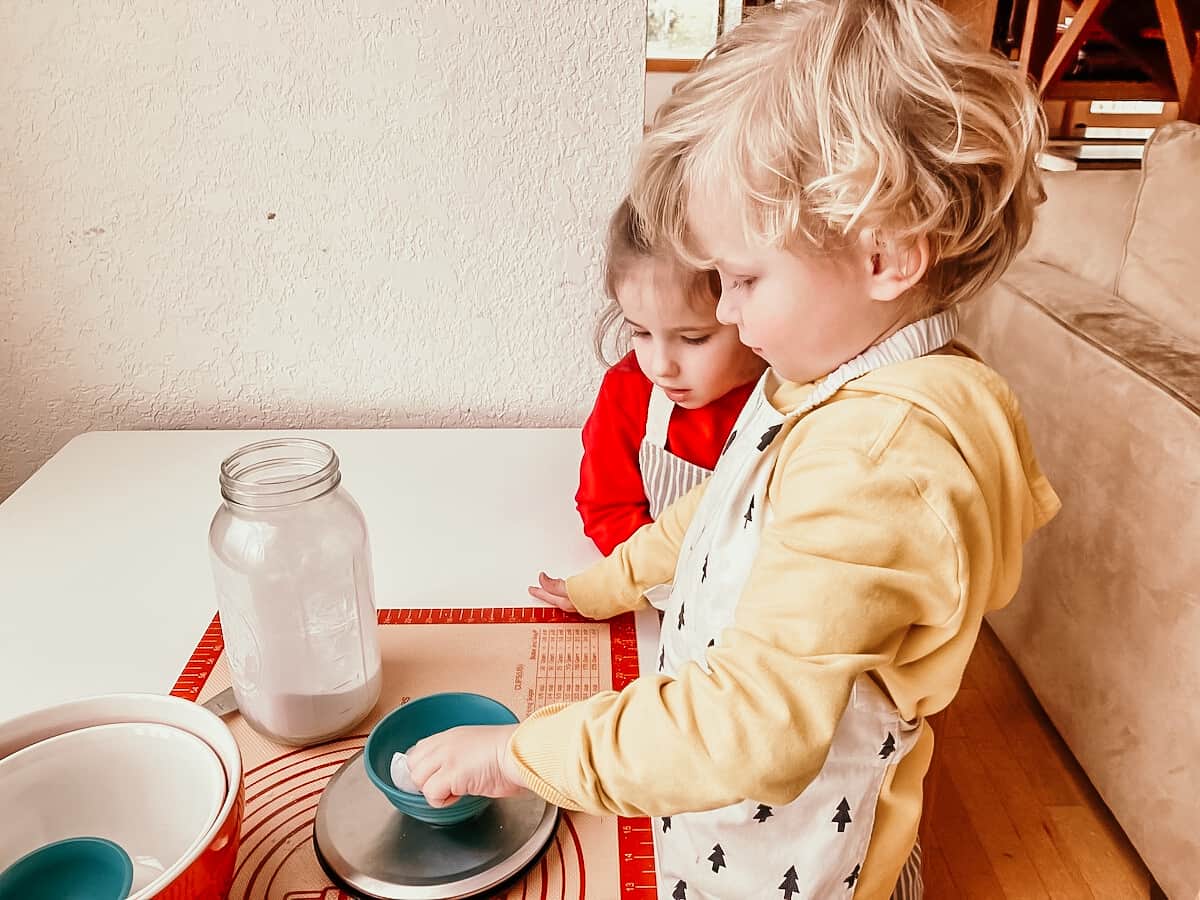
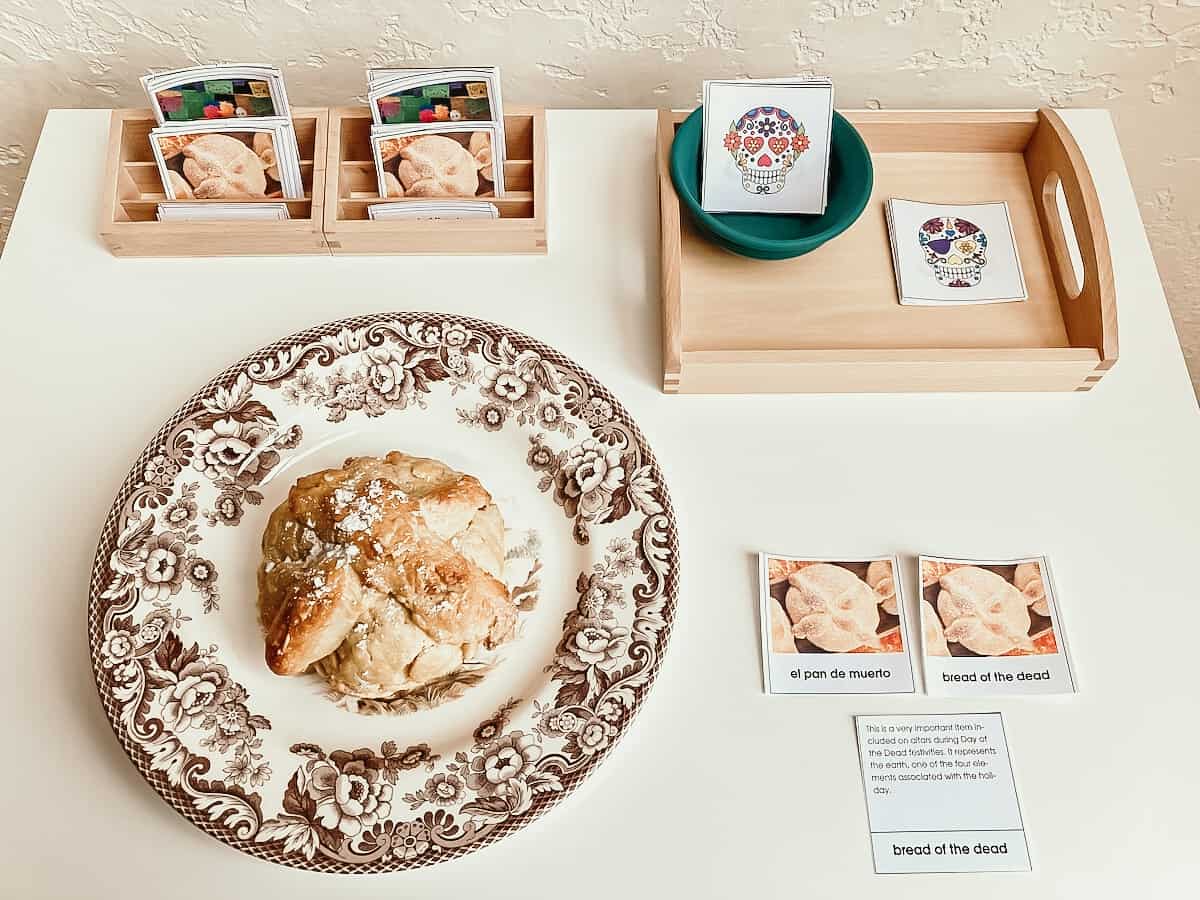
This Day of the Dead Mini Bundle was a lot of fun while learning how to make Pan de Muerto.
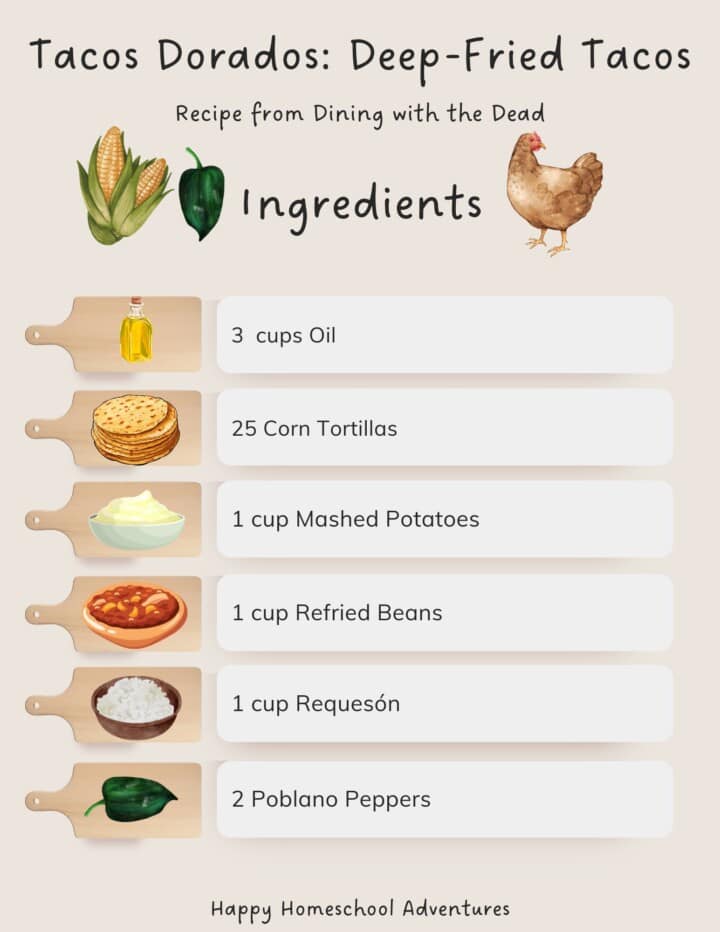
Free Tacos Dorados Recipe
Deep-fried tacos with customizable fillings & toppings.
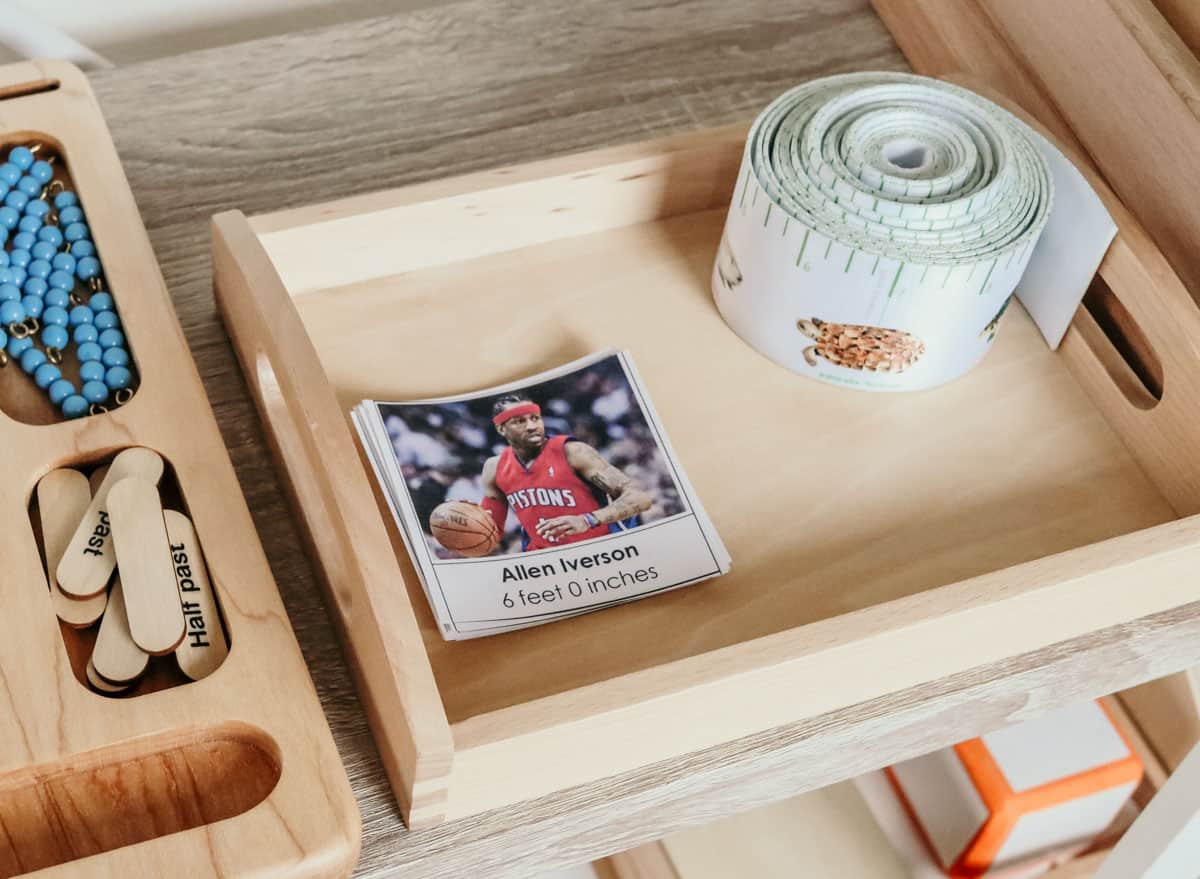
Additional Measurement Practice
Kids can also practice measurements using the March Madness Math Printable Pack and the Animals of the World Measuring Tape.


For learning about measurement of length, mass, and volume, as well as temperature conversion check out these metric measures exercises.

After the picture cards are displayed in order, kids can match the metric label to the appropriate picture.

The metric measures of length, mass, and volume can all be completed using the same process so once kids have done one, they're off and running with the other two.

There is a lot of ordering and sequencing that naturally takes place as kids work through the sets of cards.

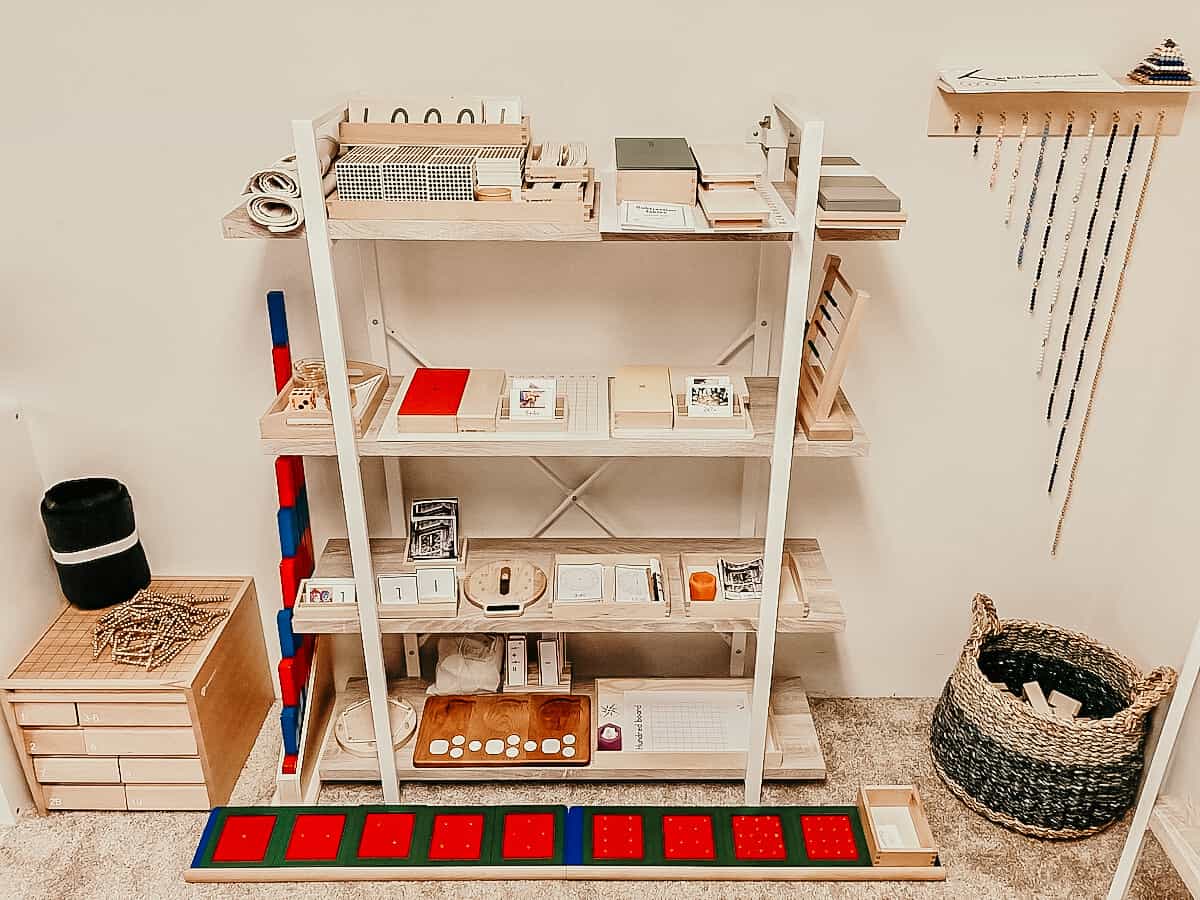
History of Numbers: Montessori Math Shelves
This is our Math area for Kaia and Noah. The Number Rods are also kept here instead of over by our 2.5 y.o.'s Math shelving unit. It's a more suitable location to keep them from being knocked down.
The square insets are out on display for the Fifth Great Lesson and introduction. They will be kept in the Fraction Cabinet after our kids have had more time to practice with them.
The thousand bead chain and mat are hanging out on the Spielgaben until I have an opportunity to hang them.
I believe everything on the top shelf is the same as the last time I shared a Math update in our Montessori Math: Concrete to Abstraction.
You can see we are still keeping the earlier works or larger pieces on the bottom two shelves. The more advanced works are on the top two shelves.
Stop by our homeschool tour to see more.
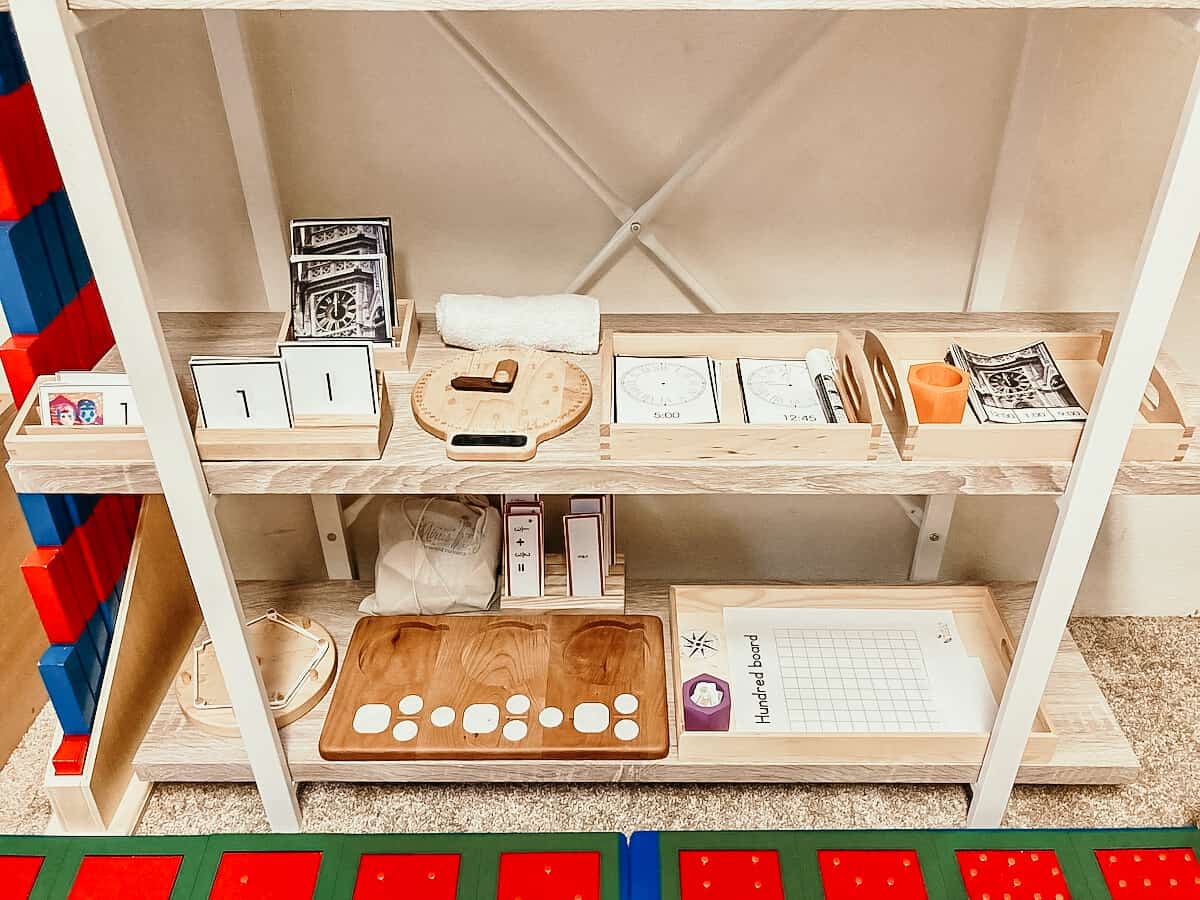
- Day of the Dead Even and Odd
- Number and Roman Numeral Matching
- Roman Numeral Clock Nomenclature Cards
- Montessori Learning Clock and Washcloth
- Roman Numeral Clock Fill-In Cards
- Roman Numeral Clock Clip Cards
- Multiplication Ring
- Fraction Manipulation Board and Simple Fraction Addition
- Compass Rose Hundred Board Treasure Map
- Square Insets
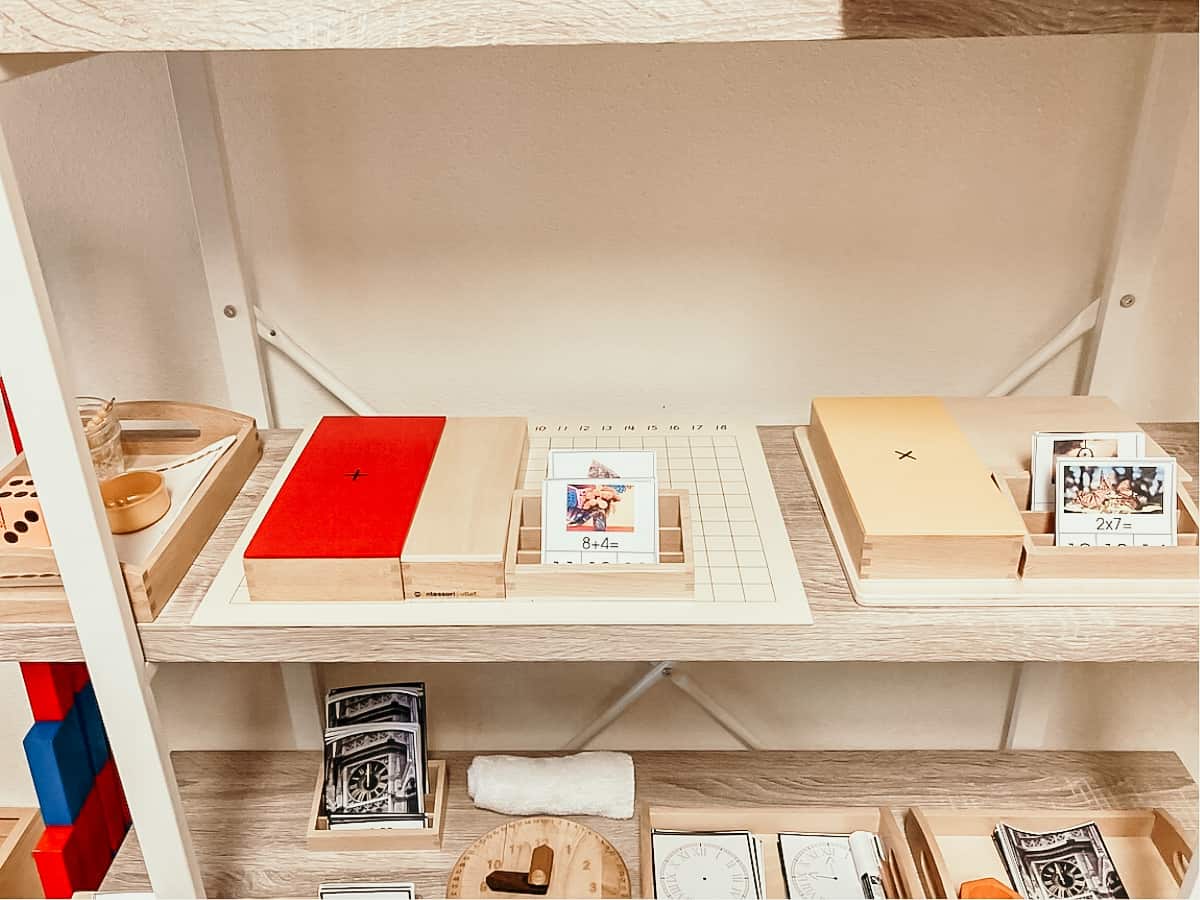
- Exchange Game
- Addition Strip Board with Addition Equations
- Day of the Dead Addition Clip Cards
- Native American Arrowhead Addition Clip Cards
- Multiplication Bead Board with Multiplication Equations
- Day of the Dead Multiplication Clip Cards
- Native American Dream Catcher Multiplication Clip Cards
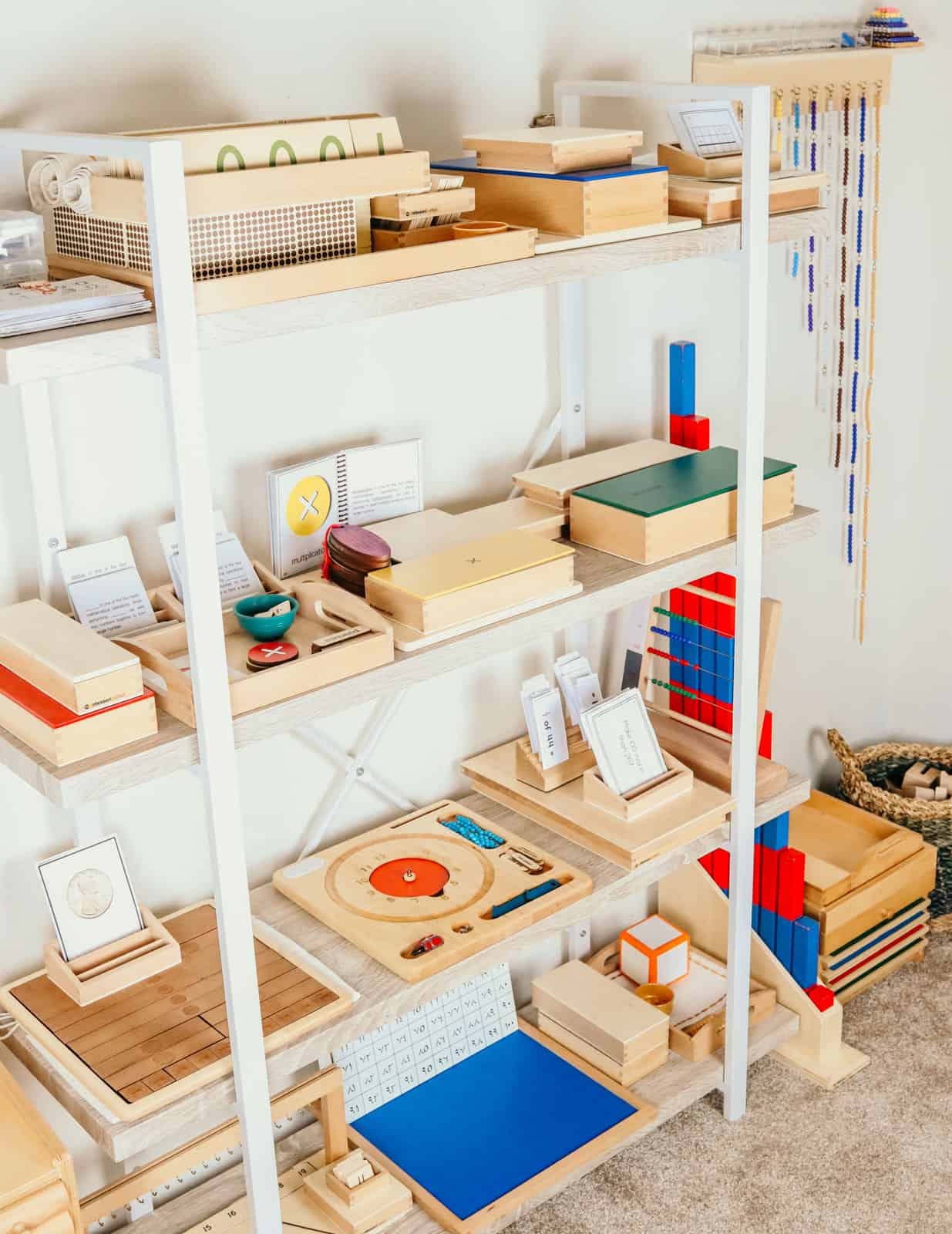
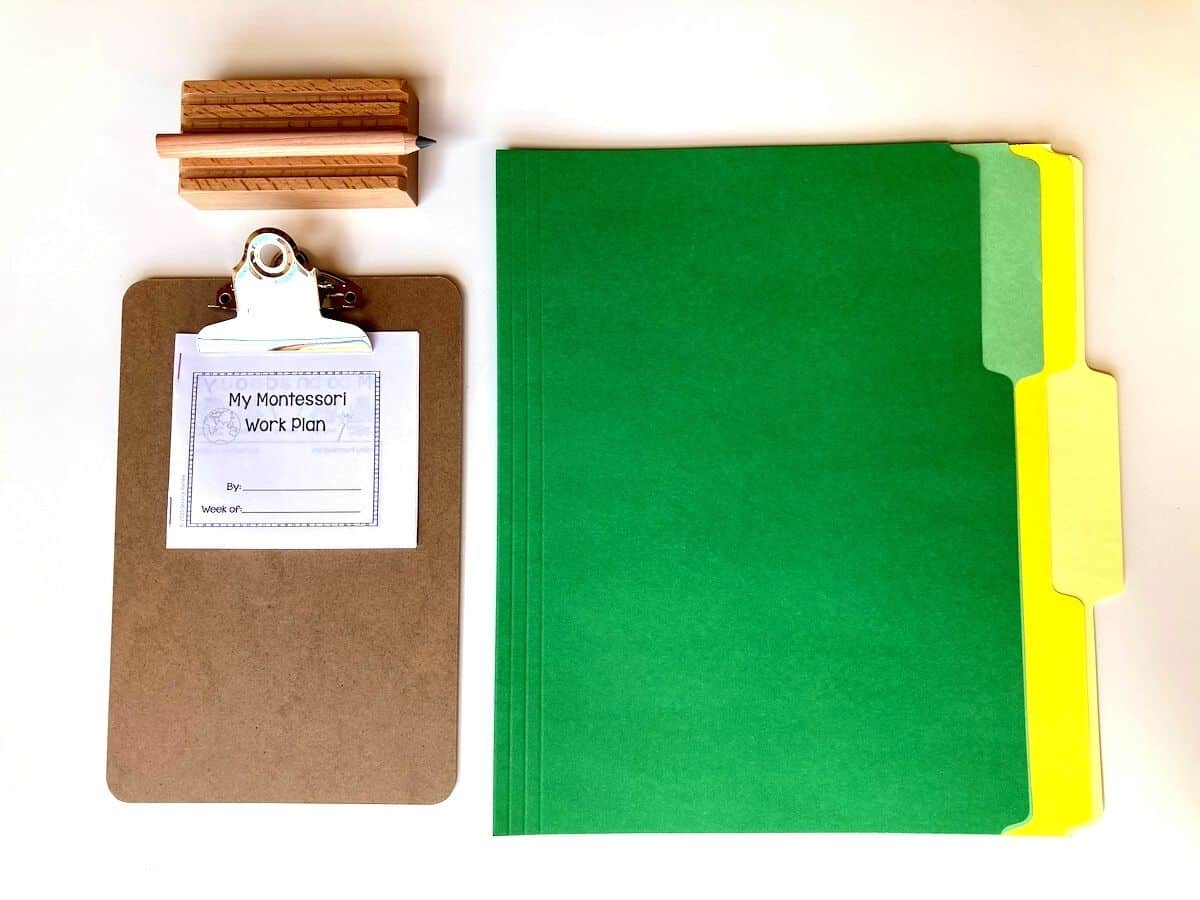
History of Numbers Work Plan and Folders
This is how Kaia and Noah document their work for each week during the History of Numbers lessons. They use these folders to keep track of it. They fill out the Montessori Work Plan at the end of their day. The folders are for ongoing work and completed work.
History of Numbers for Kids: The Montessori Fifth Great Lesson Conclusion
We hope you’ve enjoyed seeing how we do the Fifth Great Lesson. Using the primary and elementary curriculum resources, I put together a great mix of books, printables, and hands-on experiences for primary and elementary students.
There are a lot of directions you can take with this great lesson. This is how we did it. We hope you find it useful as you plan your Montessori Fifth Great Lesson experiences.
If you'd like to see any of these Math works explained in more detail, let us know in the comments. Also, don’t forget to check out our Montessori First Great Lesson if you haven’t already.
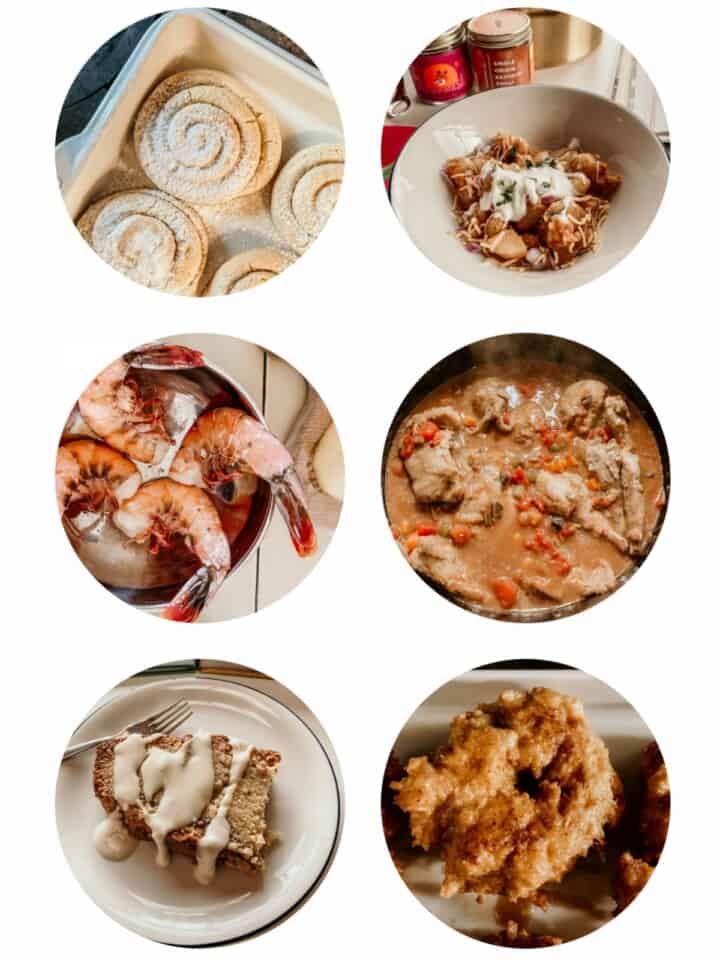
Food from Around the World: Free Cooking Lessons
Learn from some of the most talented chefs around the world!
Free Cooking Course for Families
Discover recipes for every continent! Sign up to receive free cooking lessons for the whole family. Learn from some of the most talented chefs around the world and participate in the quality practical life experiences Montessori education is known for.
Find out more about the cooking course.
More Montessori
Thanks for stopping by!
- Kristin
History of Numbers for Kids
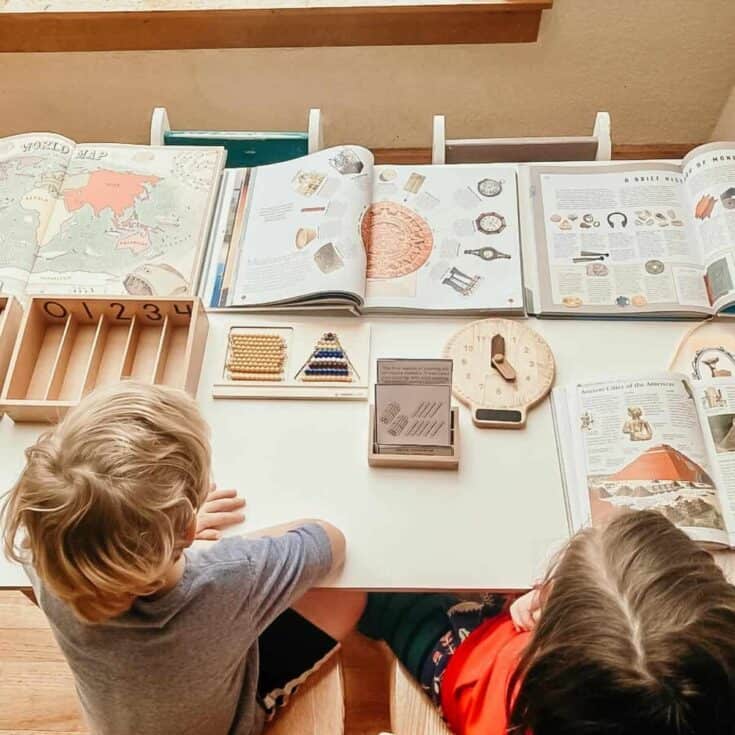
Explore the History of Numbers using the Montessori Fifth Great Lesson. These interdisciplinary lessons cover Ancient Numbers, History of Roman Numerals, Time, Calendar, Measurement, Number Systems, Money, and Geometry. This Story of Numbers includes a Birthday Celebration of Life, Dia de los Muertos learning experiences, and Pan de Muerto baking for kids.
Books, Nature Items, Hands-on Materials, & Printables
Materials
- Maps
- Timelines of Everything
- Curiosity Human World
- Encyclopedia of World History
- Montessori Math Books
- Nature Items for Sorting and Classification
- Mirus Toys Ten Frame
- Mirus Toys Montessori Teaching Clock
- Mirus Toys Clock
- Mirus Toys Moon Phases Puzzle - Calendar
- Mirus Toys Dollar Counting Board
- Mirus Toys Fraction Manipulation Board
- Metric Measures Exercises
- Waseca Biomes Seasons Mat
- Treasures from Jennifer Geometry Cards
- Treasures from Jennifer Multiplication Ring
- Montessori Spindle Boxes
- Montessori Golden beads
- Montessori Numeral Cards
- Arabic Hundred Board Tiles
- Montessori Shape Puzzles
- Montessori Trinomial Cube
- Montessori Square Insets
- Montessori Constructive Triangles
- Montessori Stamp Game
- Montessori Number Rods
- Montessori Thousand Bead Chain
- Montessori Exchange Game Colored Bead Bars
- Montessori Addition Strip Board
- Montessori Multiplication Bead Board
- Montessori Multiplication Equations Box
- Weekly Calendar Ring
- Annual Calendar Ring
- Fire Stacker Puzzle
- Magnetic Fishing Game
- Nuts and Bolts
- Farm puzzle
- Spielgaben
- March Madness Math Printable Pack
- Animals of the World Measuring Tape
- Montessori Great Lesson - Stories and Activities printable
- Day of the Dead Skull Puzzles printable (FREE)
- How Many Bones? printable (FREE)
- Day of the Dead Skull Matching printable (FREE)
- Classic Cars Pattern Matching printable
- Classic Cars Skip Counting Puzzle printable
- Telling Time Roman Numerals printable
- Roman Numerals Clock Card printable
- Balancing Equations printable
- More, Less or Equal printable
- Mirus Toys Compass Rose Hundred Board Treasure Map printable
- U.S. Currency Nomenclature Cards printable
- U.S. Coins printable
- History Timeline Cards printable
- Inventors and Inventions printable
- Cultivating Dharma Geometry Album printable (FREE)
- Fraction Addition Tickets printable
- Fractions of An Amount printable
- Pan de Muerto Recipe printable (FREE)
- Day of the Dead Nomenclature Cards printable
- Day of the Dead Even and Odd printable
- Roman Numeral Clock Clip Cards printable
- Roman Numeral Clock Nomenclature printable
- Day of the Dead Addition Clip Cards printable
- Native American Arrowhead Addition Clip Cards printable
- Day of the Dead Multiplication Clip Cards printable
- Native American Dream Catcher Multiplication Clip Cards printable
- Montessori Work Plan printable
Tools
- See Materials List
Instructions
- Deliver the Fifth Great Lesson using the Montessori Great Lessons - Stories and Activities printable. As you deliver the lesson, use hands-on Math materials from your homeschool to explore similarities and differences between concrete materials used in your homeschool vs. in ancient times.
- Provide books such as Maps, Timelines of Everything, Curiositree Human World, and Encyclopedia of World History to identify locations and for further exploration.
- The youngest of learners can practice their Math skills through counting, comparison, and sorting of items found in nature.
- Sharpen visual discrimination skills with activities such as the Day of the Dead Skull Puzzles.
- Display Toddler and Primary Math shelf activities, such as the Spindle Box and Numeral Cards with How Many Bones? to encourage repetition in early Math skills. Add a control of error to the printable as needed.
- Include the Classic Cars Pattern Matching and Skip Counting Puzzle activities in your environment for additional practice with pattern matching and skip counting.
- introduce the Roman Numerals Matching activity and encourage repetition with this work.
- Review telling time to the minute using the Montessori Learning Clock and the five bead bars. Repeat as needed and include skip counting by 5.
- Follow-up with additional activities from the Roman Numeral printable bundle.
- Use the Roman Numeral Clock Cards to practice building the time displayed from the digital timestamp onto the Montessori Learning Clock. The child can write the digital timestamp on the Learning Clock, identify the correct hand positions, and then draw the clock hands on the Clock Card printable. This reinforces knowledge of time to the minute while learning Roman Numerals.
- Introduce and encourage lot of repetition with the Calendar Rings, and the Moon Phases Puzzle Calendar. These activities can be built into your daily homeschool tasks and nurture an understanding of the rhythms of nature.
- Use the Waseca Biomes Seasons Mat to understand changes in seasons, the revolution of the Earth around the Sun, and to mark special occasions such as birthdays.
- Introduce the Balancing Equations printable with the Colored Bead Bars to explore equal amounts up to 20 and then with the Golden Beads for amounts in the thousands.
- Use activities like the More, Less, or Equal printable to compare amounts with greater than, less than, and equal signs. Add a control-of-error for self-correction. Another option would be to cut them out and create a shelf work where the child can compare two image cards.
- Introduce the Dollar Counting Board to explore money, coin values, and adding changes up to a dollar. Include U.S. Currency Nomenclature Cards. The child can also make their own coins using the U.S. Coins printable.
- Introduce the Trinomial Cube for additional practice with visual discrimination and to lay the groundwork for later algebraic experiences.
- Add the Geometry Cards to your environment to reinforce lessons related to Roman Numerals, Skip Counting, Patterns, and more. Encourage repetition in activities found in the accompanying guide.
- Continue compass work from the Fourth Great Lesson by introducing the Compass Rose Puzzle's Hundred Board Treasure Map. Encourage older kids to record the directions to each treasure.
- Provide follow-up work such as the Inventors and Inventions printables for additonal exploration of topics related to Math.
- Encourage imaginative play with the Spielgaben. The child can also use the included Nature Inspiration Cards.
- Use the Cultivating Dharma Geometry Album to deliver the lesson on Congruent, Equivalent, and Similar Figures. Provide plenty of opportunities for repetition. The Constructive Triangles can also be used to deliver or reinforce these concepts.
- Use the Fraction Manipulation Board and the Fraction Addition Tickets for a self-correcting fraction addition activity. The child can use a dry-erase pen to write the equations and their answers on the board. Afterwards, they can check their work using the fraction ring.
- Kids can solve for amounts such as ½ or ⅔'s of the cows in separate paddocks with the Montessori stamp game and fractions of an amount printable.
- Provide plenty of opportunities for Practical Life in the kitchen for additional Math experiences. Use the Pan de Muerto recipe printable to make a traditional Day of the Dead food.
- Encourage practice with Montessori Math shelf work to reinforce concepts learned during this lesson and any additional Math concepts the child may be mastering.
- Have the child complete the Montessori Work plan to document their daily completed and ongoing work. This will help the child to identify areas or subjects where additional focus should be placed. It also gives the child the opportunity to share how they feel about their work and what they would like to explore the following week.
Notes
Full Lesson Info and Pictures at: https://happyhomeschooladventures.com/montessori-fifth-great-lesson-materials-follow-up/
Recommended Products
As a member of affiliate programs, I earn from qualifying purchases.

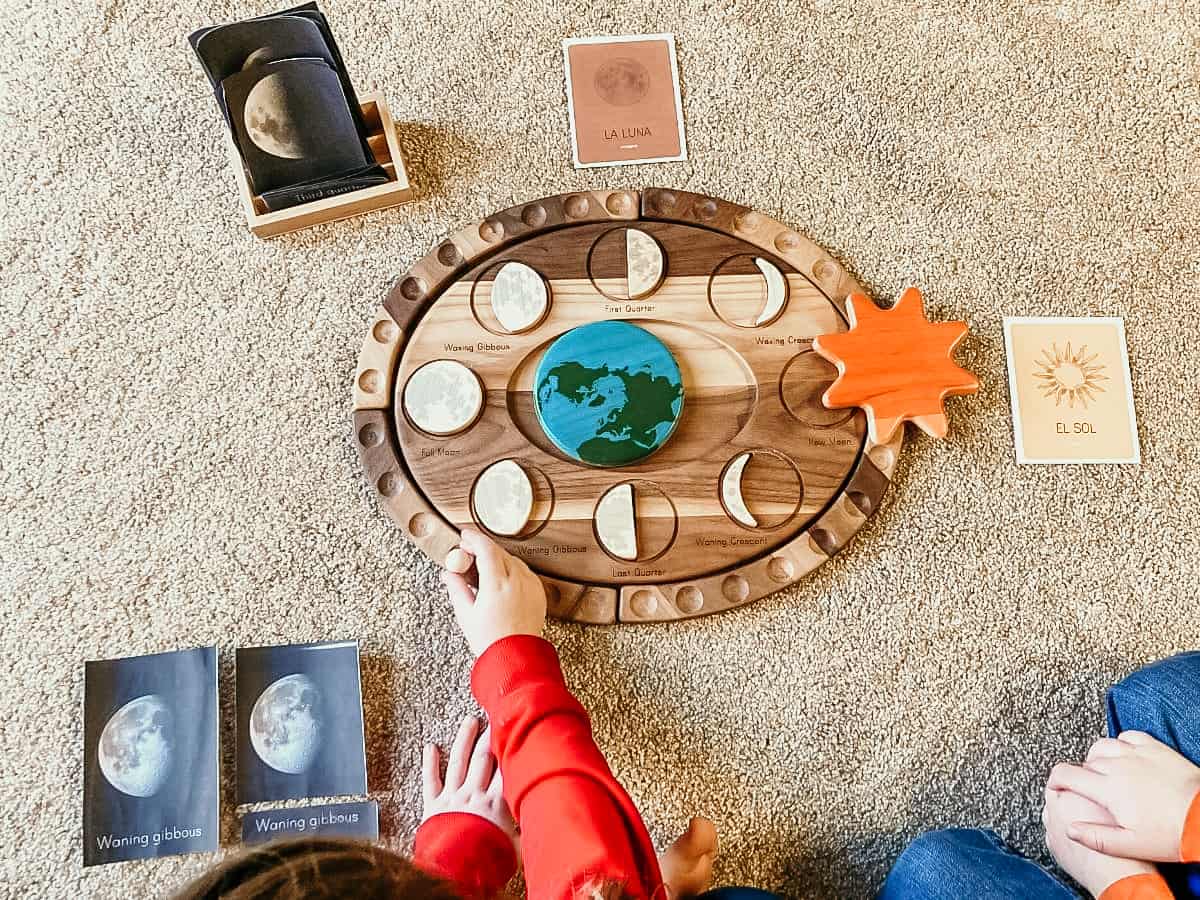
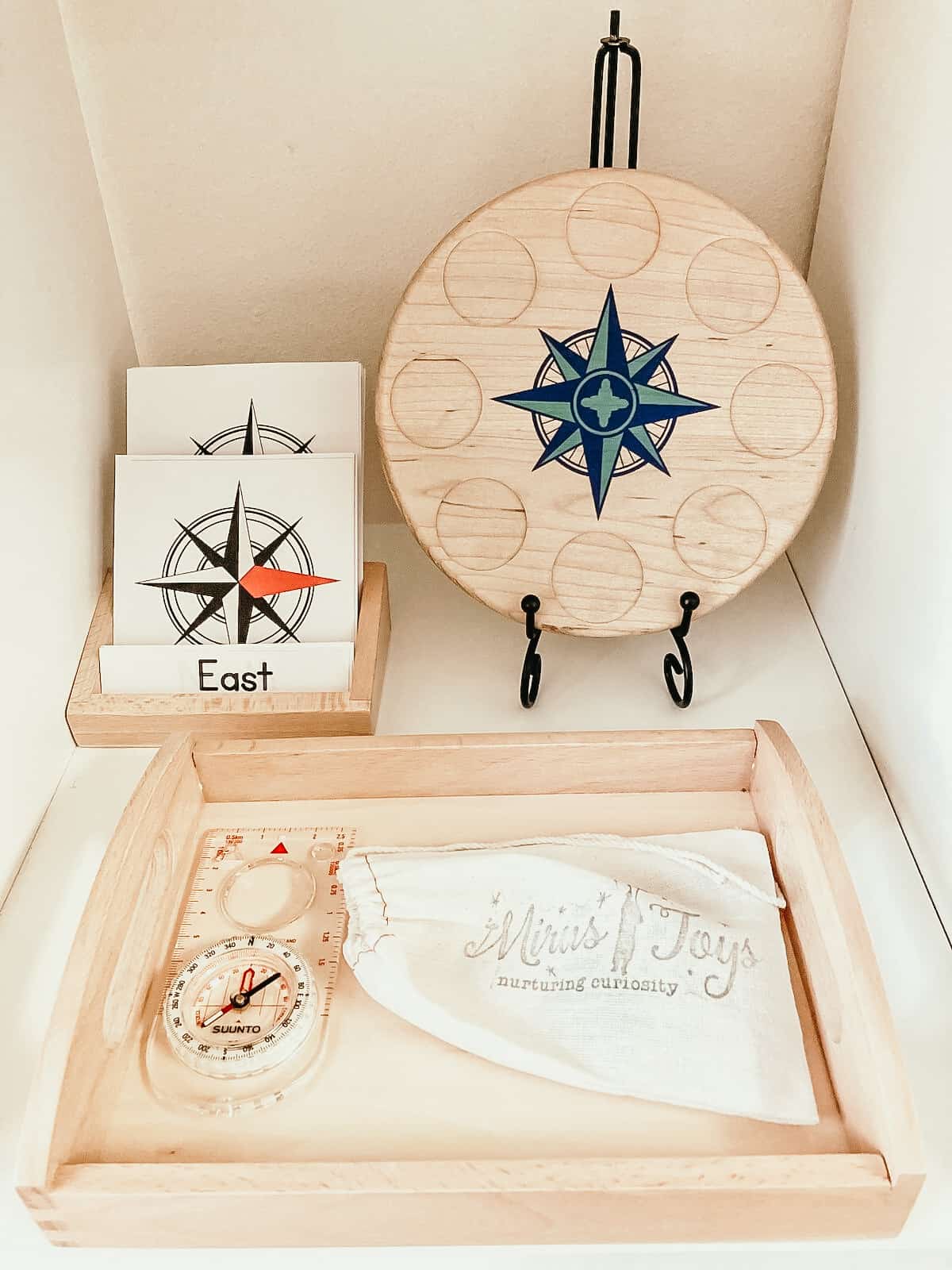
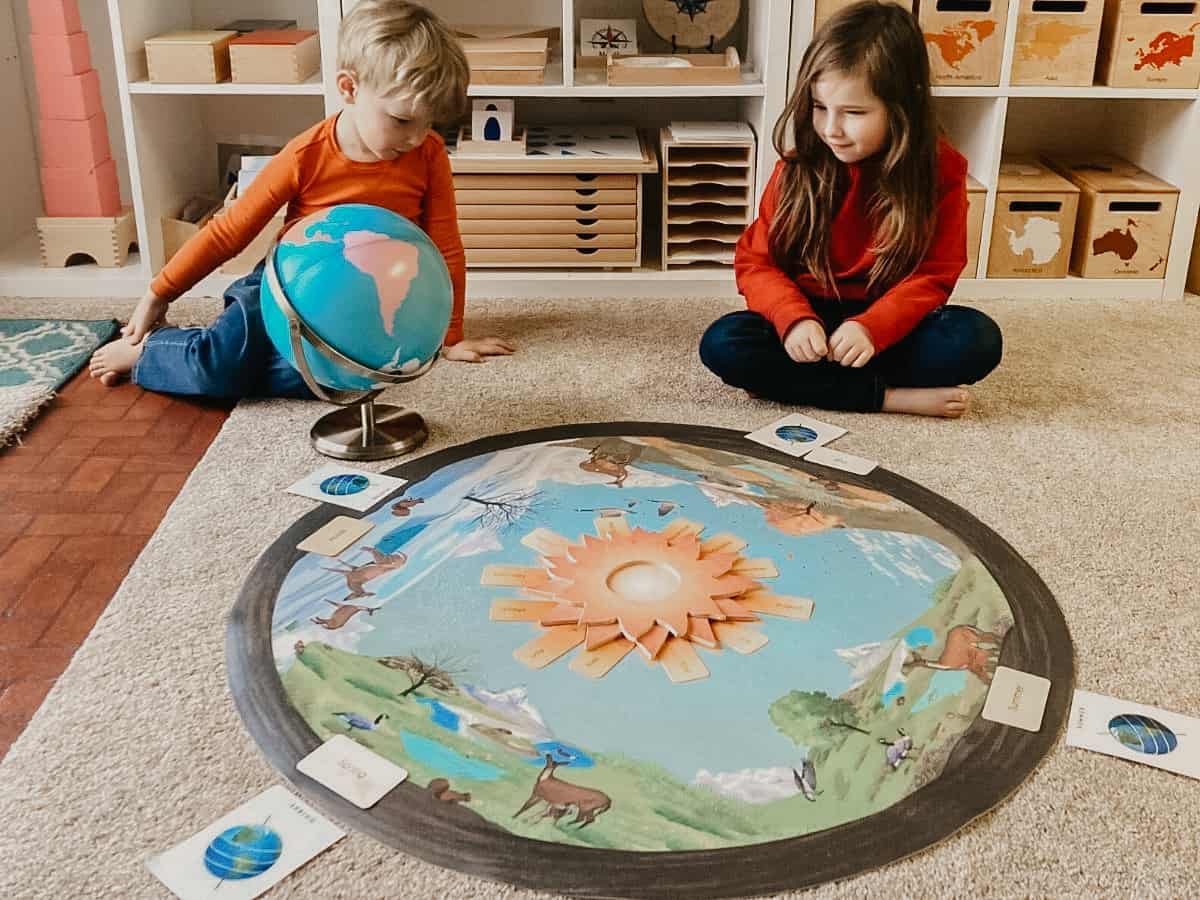

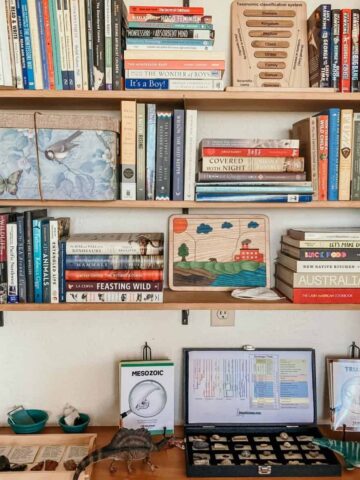
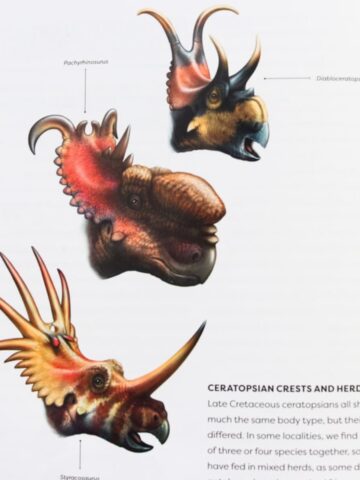
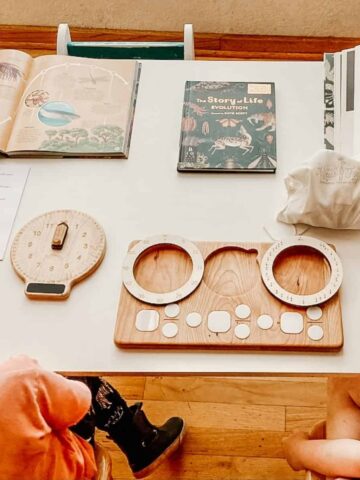
Leave a Reply